Kristine Hughes's Blog, page 67
December 4, 2015
THE DUKE OF WELLINGTON TOUR: THE WATERLOO CHAMBER AT WINDSOR CASTLE
To commemorate the victory of the British, Austrian, Prussian, Russian forces and their allies over Napoleon, George IV envisioned a splendid banquet hall. The large hall replaced several rooms in the castle and includes many limewood carvings by Grinling Gibbons and his assistants in the 1680's,salvaged from a former chapel. Most of the paintings were executed by Sir Thomas Lawrence, (1769-1830) as commissioned for the Room in Windsor Castle designed by Sir Jeffry Wyatville and completed in the reign of William IV. Unless otherwise indicated, all paintings done by Lawrence or his studio.
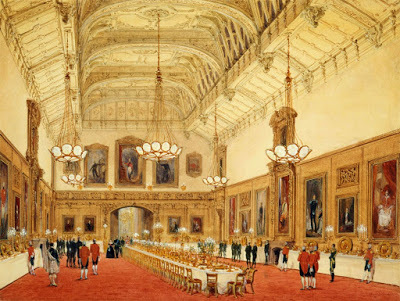 Watercolour by Joseph Nash of the Waterloo Chamber, 1844
Watercolour by Joseph Nash of the Waterloo Chamber, 1844
Royal Collection Trust/© Her Majesty Queen Elizabeth II 2014North Wall, Upper Level
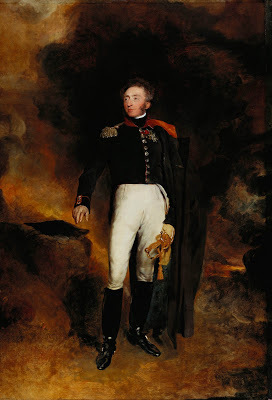 Louis-Antoine, Duke of Angouleme, 1825
Louis-Antoine, Duke of Angouleme, 1825
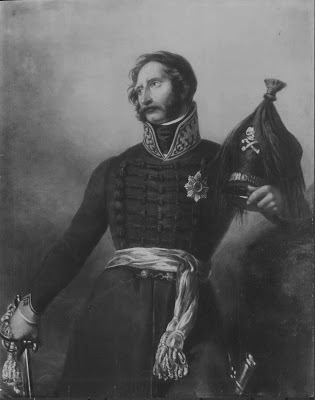 Frederick William, Duke of Brunswick, 1848 by William Corden
Frederick William, Duke of Brunswick, 1848 by William Corden
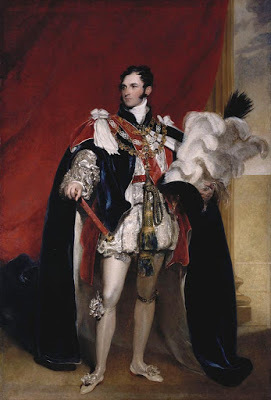 Prince Leopold of Saxe Coburg, later King of the Belgians, 1821
Prince Leopold of Saxe Coburg, later King of the Belgians, 1821
North Wall, Lower Level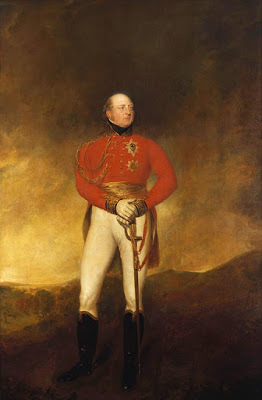 Adolphus, Duke of Cambridge, 1818
Adolphus, Duke of Cambridge, 1818
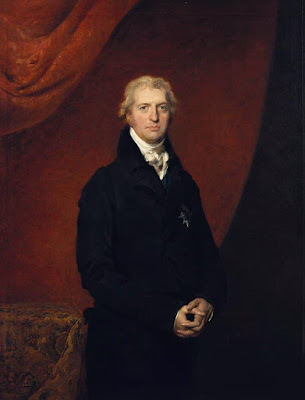 Robert Banks Jenkinson, 2nd Earl of Liverpool, c. 1820
Robert Banks Jenkinson, 2nd Earl of Liverpool, c. 1820
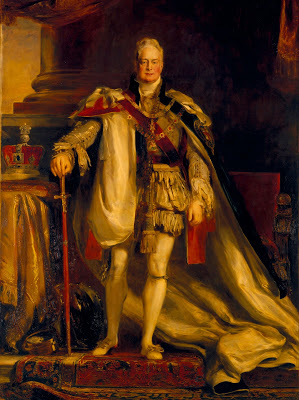 William IV, 1832, by Sir David Wilkie
William IV, 1832, by Sir David Wilkie
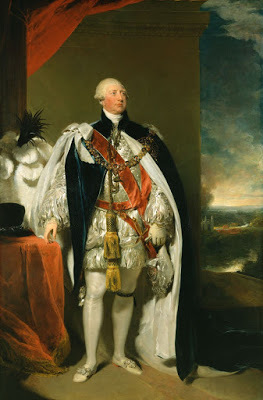 George III, 1820
George III, 1820
This portrait is a copy Lawrence and his studio made based on his painting of George III commissioned by the MPs of the City of Coventry in 1792.
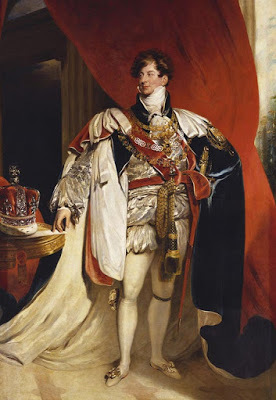 George IV c. 1820
George IV c. 1820
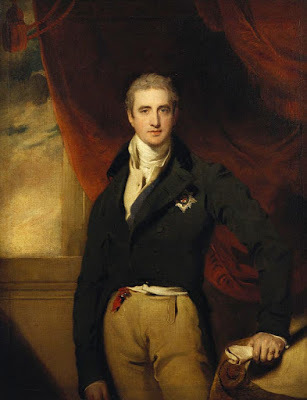 Robert Stewart, Viscount Castlereagh, c. 1817
Robert Stewart, Viscount Castlereagh, c. 1817
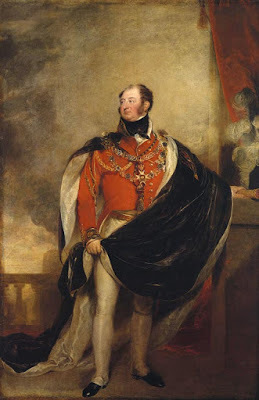 Frederick Duke of York, 1816
Frederick Duke of York, 1816
East Wall, Upper Level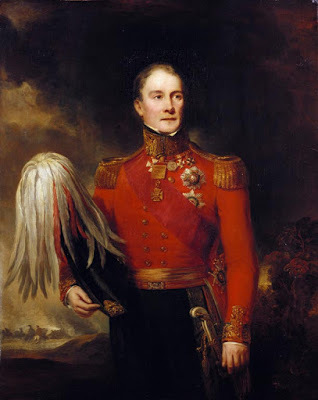 General Sir James Kempt, 1835 by Robert McInnes
General Sir James Kempt, 1835 by Robert McInnes
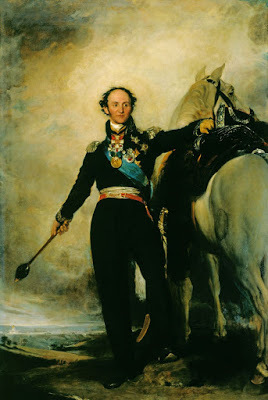 Matvei Ivanovich, Count Platov, 1814
Matvei Ivanovich, Count Platov, 1814
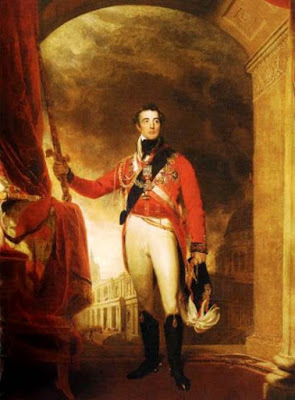 Arthur Wellesley, 1st Duke of Wellington 1814-15
Arthur Wellesley, 1st Duke of Wellington 1814-15
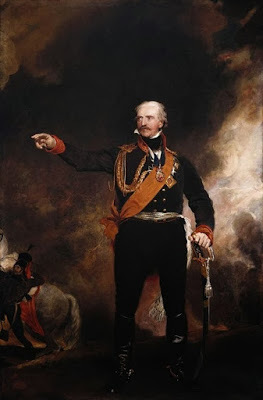 Field Marshal Gebhardt von Blucher, 1814
Field Marshal Gebhardt von Blucher, 1814
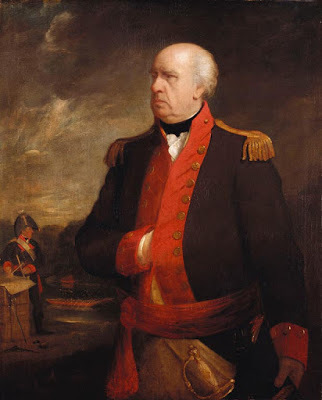 Sir William Congreve, c. 1805-10 by James Lonsdale
Sir William Congreve, c. 1805-10 by James Lonsdale
East Wall, Lower Level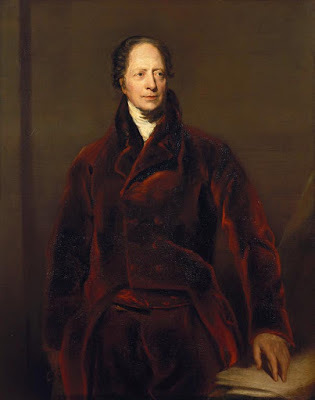 Charles William, Baron von Humboldt, 1828
Charles William, Baron von Humboldt, 1828
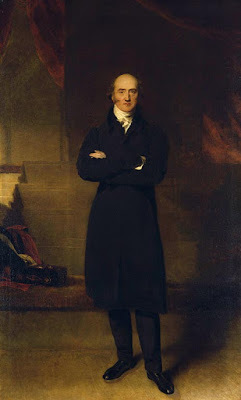 George Canning, c. 1830
George Canning, c. 1830
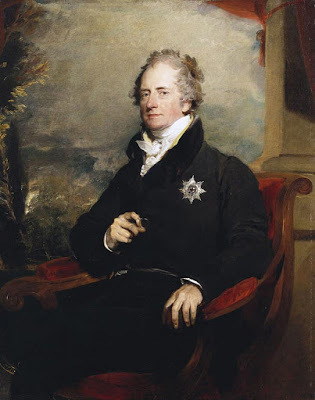 Henry, 3rd Earl Bathurst, c. 1820
Henry, 3rd Earl Bathurst, c. 1820
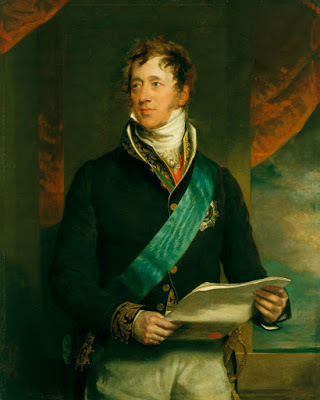 Ernest Frederick, Count Munster, 1820
Ernest Frederick, Count Munster, 1820
South Wall, Upper Level
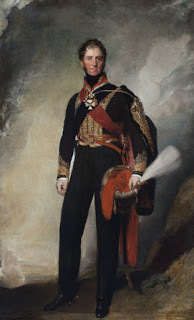 Henry Paget, 2nd Earl of Uxbridge and 1st Marquess of Anglesey, 1836 by Sir Martin Archer Shee
Henry Paget, 2nd Earl of Uxbridge and 1st Marquess of Anglesey, 1836 by Sir Martin Archer Shee
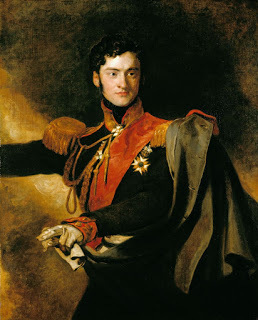 Alexander Ivanovitch Prince Chernichev, 1818
Alexander Ivanovitch Prince Chernichev, 1818
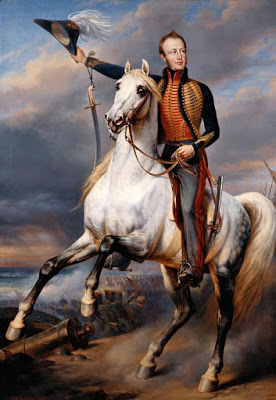 William II, King of the Netherlands, when Prince of Orange, 1846 by Nicaise de Keyser
William II, King of the Netherlands, when Prince of Orange, 1846 by Nicaise de Keyser
South Wall, Lower Level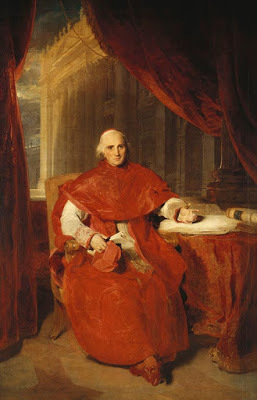 Ercole, Cardinal Consalvi, 1819
Ercole, Cardinal Consalvi, 1819
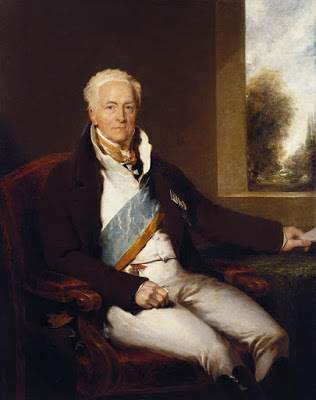 Charles Augustus, Prince Hardenberg, 1818
Charles Augustus, Prince Hardenberg, 1818
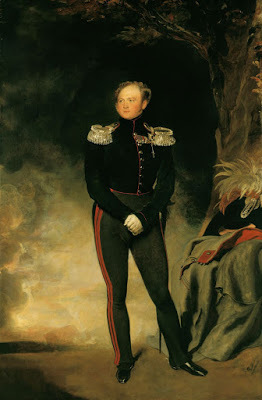 Tsar Alexander I, 1814-18
Tsar Alexander I, 1814-18
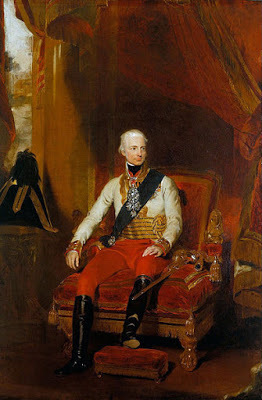 Emperor Francis I of Austria, 1818-19
Emperor Francis I of Austria, 1818-19
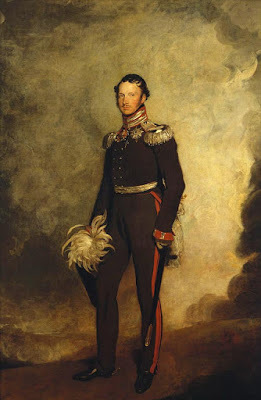 Frederick William of Prussia, 1814-18
Frederick William of Prussia, 1814-18
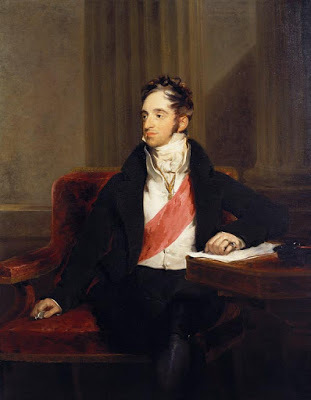 Charles Robert, Count Nesselrode, 1818
Charles Robert, Count Nesselrode, 1818
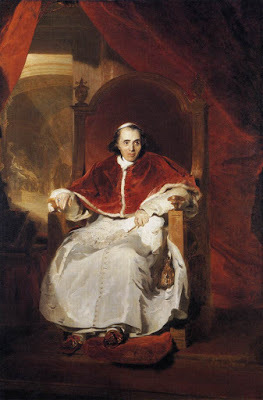 Pope Pius VII, 1819
Pope Pius VII, 1819
West Wall, Upper Level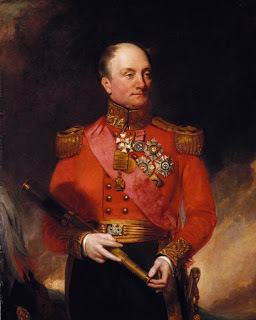 General Viscount Hill, c. 1820 by Henry William Pickersgill
General Viscount Hill, c. 1820 by Henry William Pickersgill
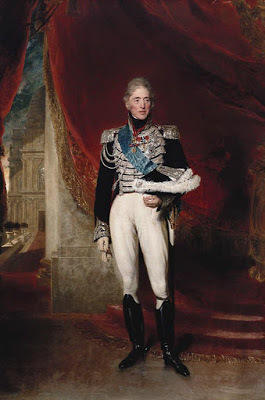 Charles X of France, 1825
Charles X of France, 1825
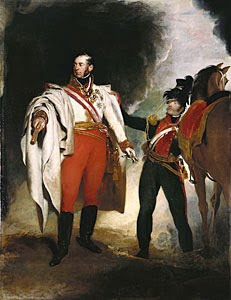 Charles Philip, Prince Schwartzenberg, 1819
Charles Philip, Prince Schwartzenberg, 1819
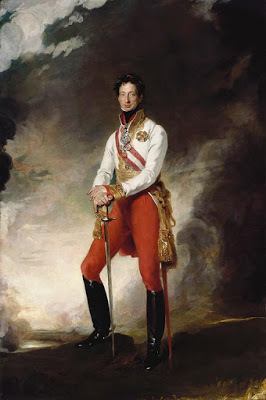 Charles, Archduke of Austria, 1819
Charles, Archduke of Austria, 1819
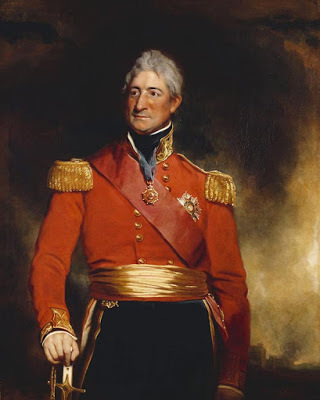 Sir Thomas Picton, 1836 by Sir Martin Archer Shee
Sir Thomas Picton, 1836 by Sir Martin Archer Shee
West Wall, Lower Level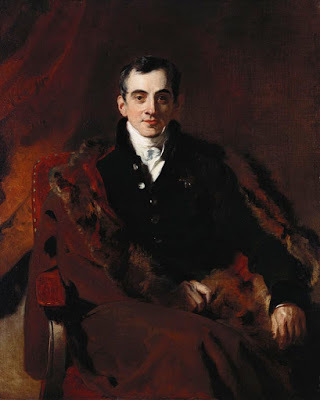 John, Count Capo D'Istria 1818-19
John, Count Capo D'Istria 1818-19
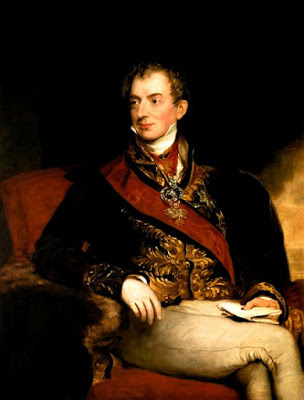 Clemens Lothar Wenzel, Prince Metternich, 1819
Clemens Lothar Wenzel, Prince Metternich, 1819
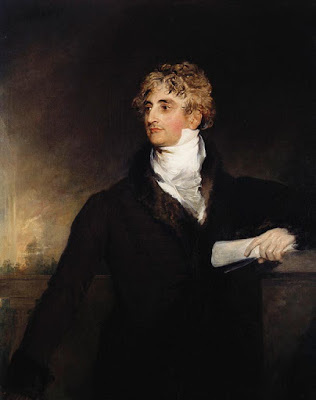 Armand Emmanuel, Duke of Richlelieu, 1818
Armand Emmanuel, Duke of Richlelieu, 1818
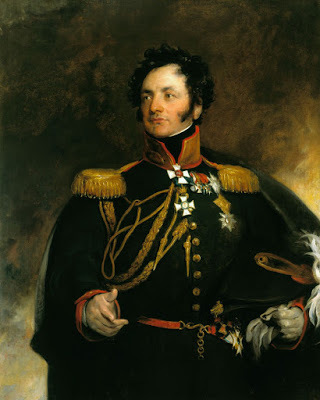 General Theodore Petrovich Uvarov, 1818
General Theodore Petrovich Uvarov, 1818
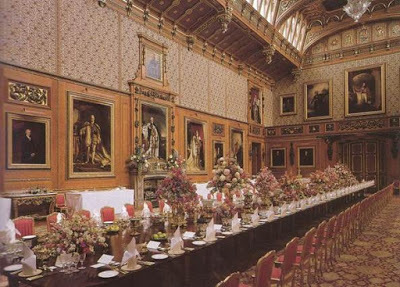
Views of the Waterloo Chamber, above and below
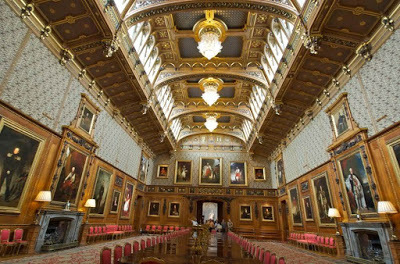
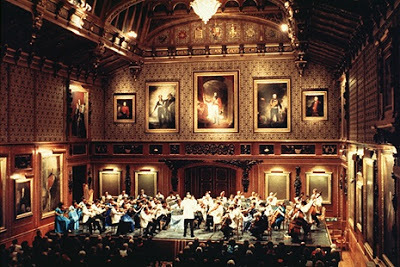 Waterloo Chamber, as concert venue
Waterloo Chamber, as concert venue
For a virtual tour of the Waterloo Chamber, click here.
 Watercolour by Joseph Nash of the Waterloo Chamber, 1844
Watercolour by Joseph Nash of the Waterloo Chamber, 1844Royal Collection Trust/© Her Majesty Queen Elizabeth II 2014North Wall, Upper Level
 Louis-Antoine, Duke of Angouleme, 1825
Louis-Antoine, Duke of Angouleme, 1825 Frederick William, Duke of Brunswick, 1848 by William Corden
Frederick William, Duke of Brunswick, 1848 by William Corden Prince Leopold of Saxe Coburg, later King of the Belgians, 1821
Prince Leopold of Saxe Coburg, later King of the Belgians, 1821North Wall, Lower Level
 Adolphus, Duke of Cambridge, 1818
Adolphus, Duke of Cambridge, 1818 Robert Banks Jenkinson, 2nd Earl of Liverpool, c. 1820
Robert Banks Jenkinson, 2nd Earl of Liverpool, c. 1820 William IV, 1832, by Sir David Wilkie
William IV, 1832, by Sir David Wilkie George III, 1820
George III, 1820This portrait is a copy Lawrence and his studio made based on his painting of George III commissioned by the MPs of the City of Coventry in 1792.
 George IV c. 1820
George IV c. 1820 Robert Stewart, Viscount Castlereagh, c. 1817
Robert Stewart, Viscount Castlereagh, c. 1817 Frederick Duke of York, 1816
Frederick Duke of York, 1816East Wall, Upper Level
 General Sir James Kempt, 1835 by Robert McInnes
General Sir James Kempt, 1835 by Robert McInnes Matvei Ivanovich, Count Platov, 1814
Matvei Ivanovich, Count Platov, 1814 Arthur Wellesley, 1st Duke of Wellington 1814-15
Arthur Wellesley, 1st Duke of Wellington 1814-15 Field Marshal Gebhardt von Blucher, 1814
Field Marshal Gebhardt von Blucher, 1814 Sir William Congreve, c. 1805-10 by James Lonsdale
Sir William Congreve, c. 1805-10 by James LonsdaleEast Wall, Lower Level
 Charles William, Baron von Humboldt, 1828
Charles William, Baron von Humboldt, 1828 George Canning, c. 1830
George Canning, c. 1830 Henry, 3rd Earl Bathurst, c. 1820
Henry, 3rd Earl Bathurst, c. 1820 Ernest Frederick, Count Munster, 1820
Ernest Frederick, Count Munster, 1820South Wall, Upper Level
 Henry Paget, 2nd Earl of Uxbridge and 1st Marquess of Anglesey, 1836 by Sir Martin Archer Shee
Henry Paget, 2nd Earl of Uxbridge and 1st Marquess of Anglesey, 1836 by Sir Martin Archer Shee Alexander Ivanovitch Prince Chernichev, 1818
Alexander Ivanovitch Prince Chernichev, 1818 William II, King of the Netherlands, when Prince of Orange, 1846 by Nicaise de Keyser
William II, King of the Netherlands, when Prince of Orange, 1846 by Nicaise de KeyserSouth Wall, Lower Level
 Ercole, Cardinal Consalvi, 1819
Ercole, Cardinal Consalvi, 1819 Charles Augustus, Prince Hardenberg, 1818
Charles Augustus, Prince Hardenberg, 1818 Tsar Alexander I, 1814-18
Tsar Alexander I, 1814-18 Emperor Francis I of Austria, 1818-19
Emperor Francis I of Austria, 1818-19  Frederick William of Prussia, 1814-18
Frederick William of Prussia, 1814-18 Charles Robert, Count Nesselrode, 1818
Charles Robert, Count Nesselrode, 1818 Pope Pius VII, 1819
Pope Pius VII, 1819West Wall, Upper Level
 General Viscount Hill, c. 1820 by Henry William Pickersgill
General Viscount Hill, c. 1820 by Henry William Pickersgill Charles X of France, 1825
Charles X of France, 1825 Charles Philip, Prince Schwartzenberg, 1819
Charles Philip, Prince Schwartzenberg, 1819 Charles, Archduke of Austria, 1819
Charles, Archduke of Austria, 1819 Sir Thomas Picton, 1836 by Sir Martin Archer Shee
Sir Thomas Picton, 1836 by Sir Martin Archer SheeWest Wall, Lower Level
 John, Count Capo D'Istria 1818-19
John, Count Capo D'Istria 1818-19 Clemens Lothar Wenzel, Prince Metternich, 1819
Clemens Lothar Wenzel, Prince Metternich, 1819 Armand Emmanuel, Duke of Richlelieu, 1818
Armand Emmanuel, Duke of Richlelieu, 1818 General Theodore Petrovich Uvarov, 1818
General Theodore Petrovich Uvarov, 1818
Views of the Waterloo Chamber, above and below

 Waterloo Chamber, as concert venue
Waterloo Chamber, as concert venueFor a virtual tour of the Waterloo Chamber, click here.
Published on December 04, 2015 00:30
December 1, 2015
MAGIC AND MYSTERY DINNER WITH THE GEORGIAN DINING ACADEMY
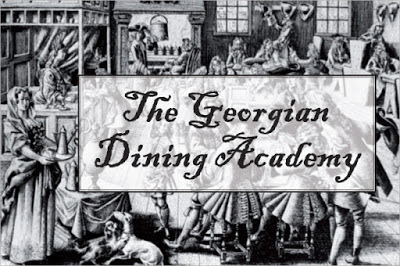
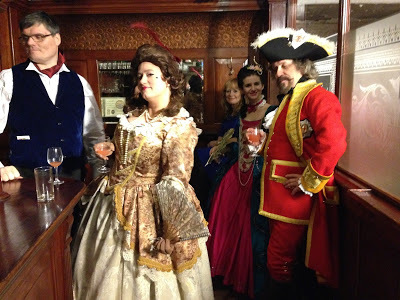
PresentsAn Evening of Mystery and Magic10th December 2015Arrive at 7pm - Carriages 11pm
An historic dining experience transporting guests to the Georgian period, an evening engaging in the frivolity, fun and fine dining within a chop house established in 1757.
In conjunction with Simpson Tavern at 38 ½ Cornhill, London EC3V 9DR, we offer all drinks included, plus a three course supper, entertainment and dashes of history of the City and the Georgians throughout the evening, with music, poetry and song. The rooms are candlelit, so most atmospheric. The Tavern is usually open during the day only, so we are offering an unusual experience in a unique venue.
THE DATEThe Georgian Dining Academy is offering an evening of ‘Magic and Mystery’ on 10th December 2015, starting at 7pm, Carriages at 11pm. Booking through Eventbrite - click here for details.
THE GUESTSAn ideal occasion for the single, couples and tables of six, or groups if required. We can seat up to 70 people. Please note a costume is not required but welcomed and encouraged. On this festive occasion masks are required to be worn by the guests on arrival.
THE MENUA festive menu to tempt all, with a warming punch to welcome you, made from a secret recipe created by Miss Kitty Pridden one of the hosts. The menu is pre-order and closely resembles a Georgian feast as we can achieve. We also cater for dietary requirements.
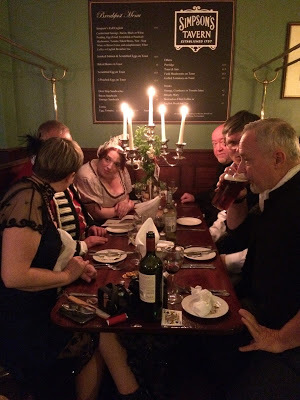
MORE INFORMATIONThe Georgian Dining Academy grew out of an idea by Tina Baxter, aka Miss B Takes a Walk, who qualified as a City of London Guide in 2012. The purpose of the Academy is to create a Georgian, performance style, dining experience in the heart of the City. With the encouragement of Miss Kitty Pridden (also a City Guide of 2012) this novel idea was put into action in 2014. It has proved a successful event which takes place quarterly.
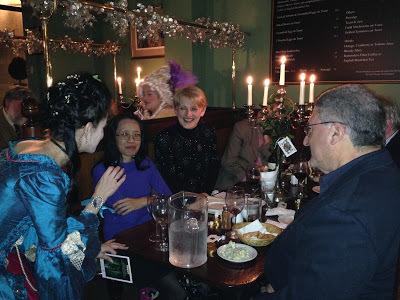
The dates for 2016 have already been agreed with Simpson’s Tavern and will be announced in early 2016.Plans are afoot for a ‘Club Membership’ package to be released soon. Dates upon application. Further details:
CONTACT:
Miss B Takes A WalkCurrent Walks : http://bit.ly/18rCd4aCurrent Event: http://bit.ly/1L5NkN707963778213www.missbtakesawalk.blogspot.com
Published on December 01, 2015 23:30
November 30, 2015
HORSES, HORSES, HORSES...
HORSES, HORSES, HORSES...A VISIT TO THE KENTUCKY HORSE PARK
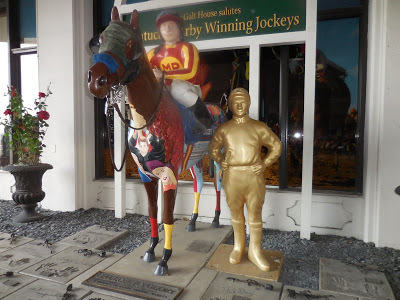 Outside the Galt House Hotel, you'd know you were in Kentucky even if the surrounding architecture looked like the picture below.
Outside the Galt House Hotel, you'd know you were in Kentucky even if the surrounding architecture looked like the picture below.
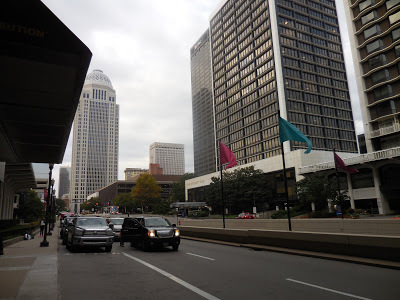
As we drove from Louisville toward Lexington, I regressed a few years back to my horse-crazy days...as a pre-teen and teen, when about the only thing I wanted to do was ride -- or even muck out the stalls. So by the time we arrived at the Kentucky Horse Park, I had become age 13. At least as concerned horses -- I doubt I'd ever want to experience high school all over again. Would you??
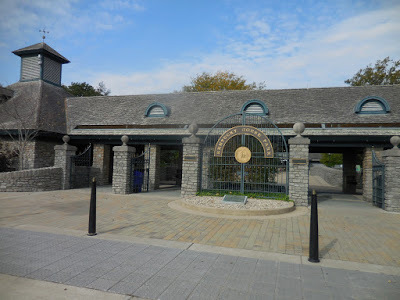 A bit over an hour from Louisville on the edge of Lexingtonis the Kentucky Horse Park, right in the enter of the Bluegrass Region.
A bit over an hour from Louisville on the edge of Lexingtonis the Kentucky Horse Park, right in the enter of the Bluegrass Region.
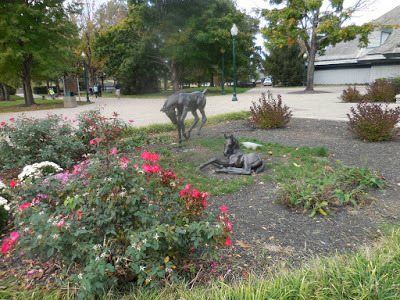 Many statues about, these of frolicking colts
Many statues about, these of frolicking colts
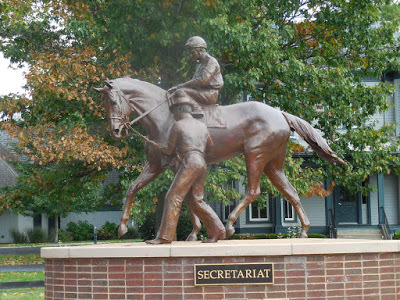 Secretariat, 1970-1989Winner of the 1983 Triple Crown
Secretariat, 1970-1989Winner of the 1983 Triple Crown
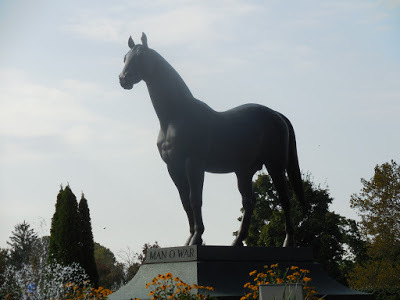 Above and below, Man O'War
Above and below, Man O'War
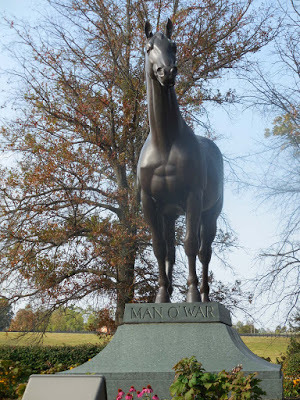
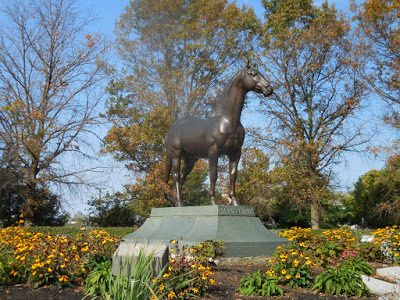
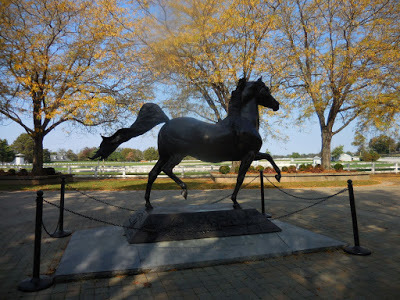 Unnamed prancer
Unnamed prancer
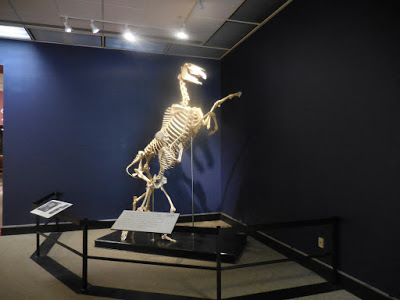 Skeletons of man and horse, paired for eons
Skeletons of man and horse, paired for eons
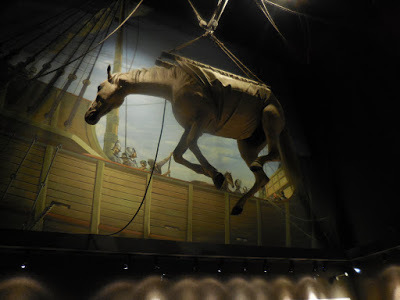 How horses began their travel by sea
How horses began their travel by sea
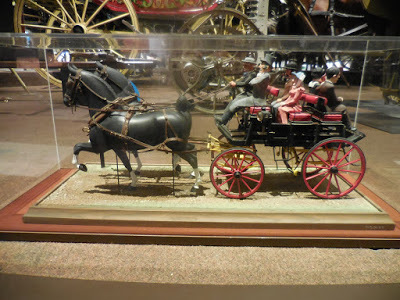 Miniature Hackneys
Miniature Hackneys
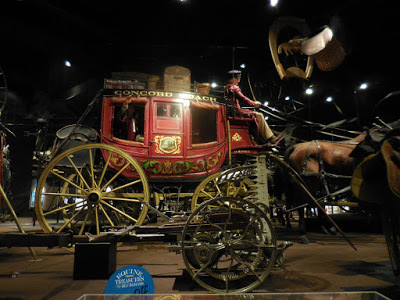 Old Stagecoach
Old Stagecoach
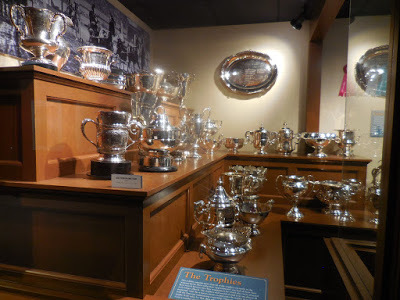 A selection of the many trophies won by the iconic Calumet Farms
A selection of the many trophies won by the iconic Calumet Farms
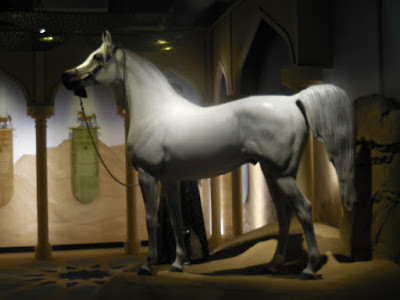 A section of the museum was devoted to the Arabian Horse: flourishing today all over the world and founding breed of many other contemporary breeds
A section of the museum was devoted to the Arabian Horse: flourishing today all over the world and founding breed of many other contemporary breeds
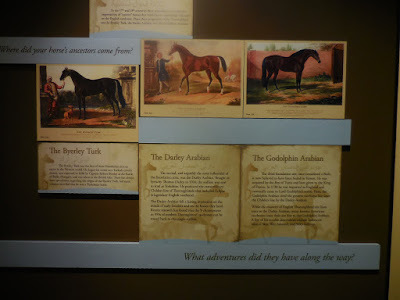 The three founders of the thoroughbred: The Byerly Turk, the Darley Arabian and the Godolphin Arabian.
The three founders of the thoroughbred: The Byerly Turk, the Darley Arabian and the Godolphin Arabian.
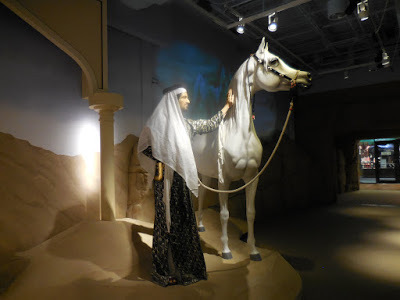
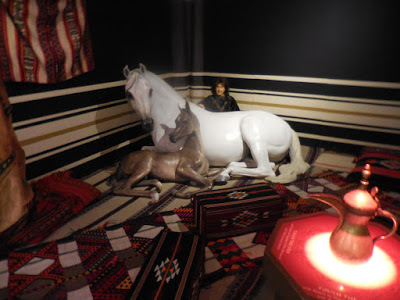 Bedouins are famous for the care of their horses
Bedouins are famous for the care of their horses
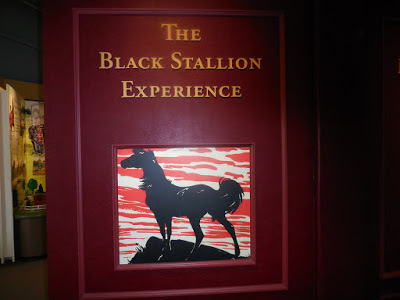 Was this one of your favorites in your teens?? Oh, Walter Farley, you are in part responsible for my career in writing!!
Was this one of your favorites in your teens?? Oh, Walter Farley, you are in part responsible for my career in writing!!
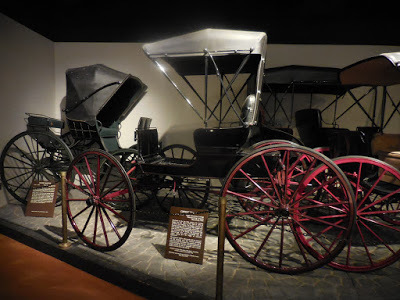 A Corning Buggy, 1900
A Corning Buggy, 1900
Developed in New York in about 1875 for two persons. Often used as a doctor's country vehuicle.
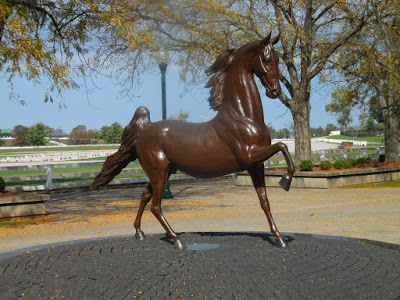 American Saddlebred
American Saddlebred
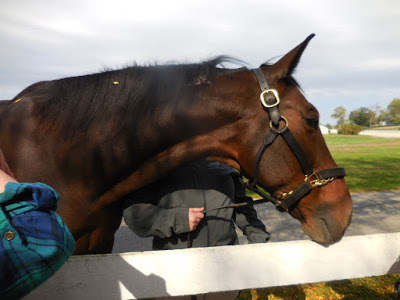
Just so you know, there are many live horses around, not just statues and museum displays.
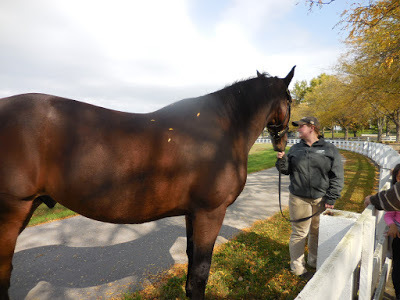
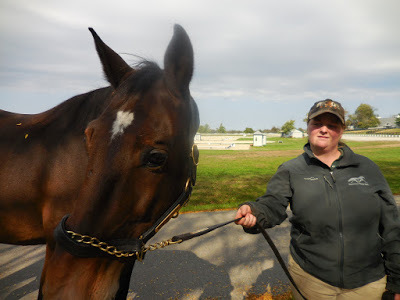
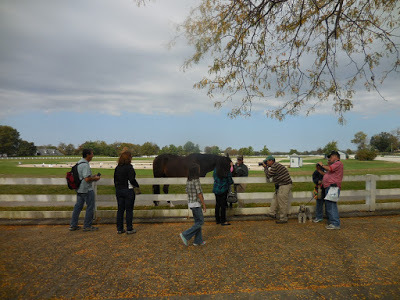
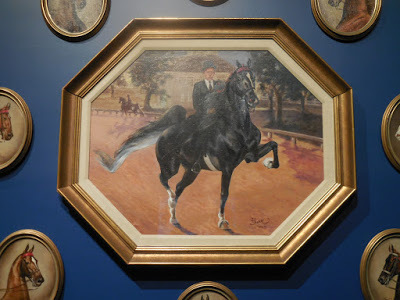
A picture of my teen favorite, the five-gaited champion Wing Commander;painting by Gwen Reardon, 1971
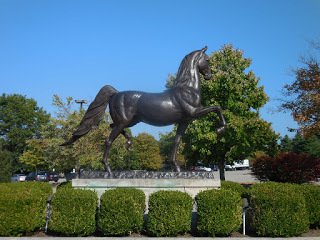 A five-gated statue or more correctly, a statue of a five-gaited horse
A five-gated statue or more correctly, a statue of a five-gaited horse
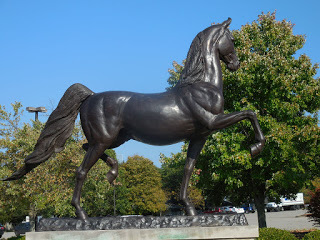
My husband was game for a tour of nearby horse farms, and we took off with about 14 companions and our guide, Shawn -- he was the best! He explained that the Horse Park and most of the Bluegrass farms had changed from white fences to black. Why? Because they have to be painted less frequently and save a lot of money. After all, though lots of starry-eyed girls like me would never consider such a thing, breeding and training horses is a business.
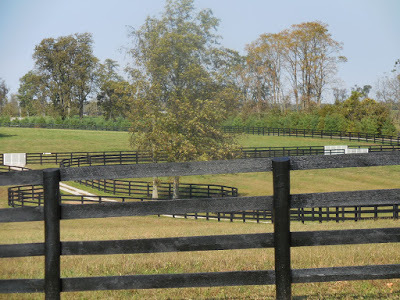
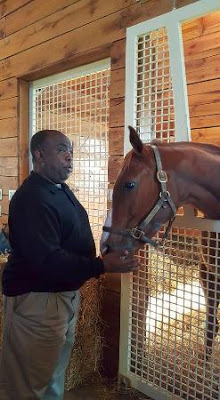 Our guide Shawn, from Unique Horse Farm Tours
Our guide Shawn, from Unique Horse Farm Tours
Our first stop was Windstar Farm (website here) where more than twenty stallions stand at stud.
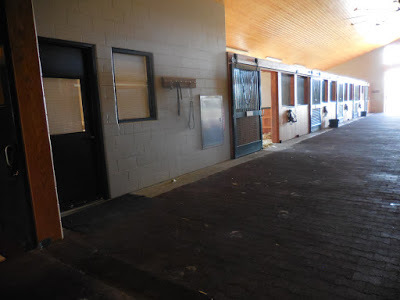 This fine barn houses only stallions, in the ultimate equine luxury
This fine barn houses only stallions, in the ultimate equine luxury
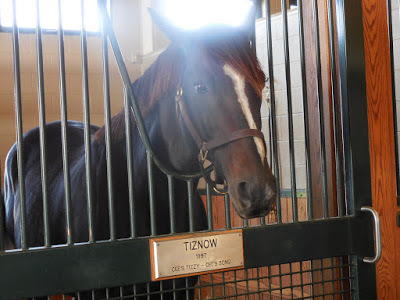 Tiznow
Tiznow
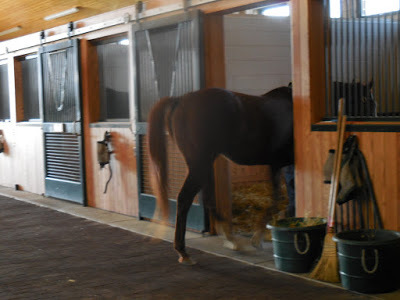 I just wasn't quick enough to catch this fine fellow in time!
I just wasn't quick enough to catch this fine fellow in time!
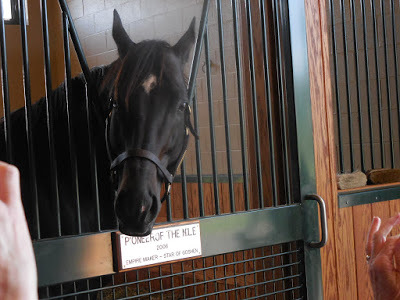 This is Pioneer of the Nile, sire of 2015 Triple Crown winner and Breeders Cup champ, American Pharaoh.
This is Pioneer of the Nile, sire of 2015 Triple Crown winner and Breeders Cup champ, American Pharaoh.
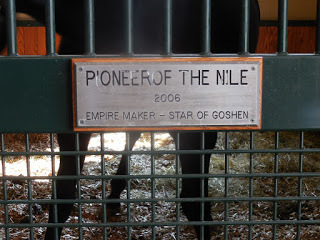
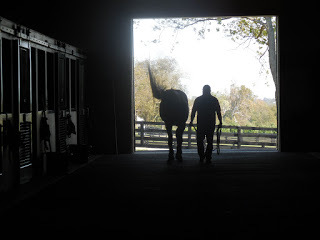 Each stallion gets his daily exercise and constant coddling.
Each stallion gets his daily exercise and constant coddling.
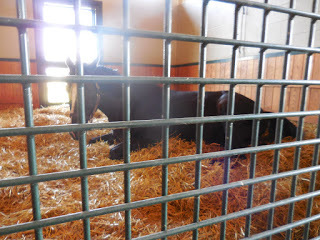 Afternoon nap
Afternoon nap
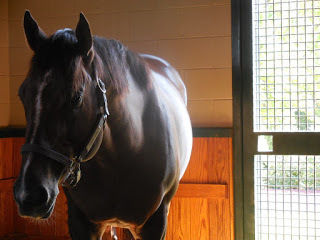
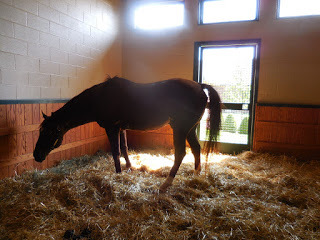 The stalls are spacious and the horses are treated better than lots of humans!
The stalls are spacious and the horses are treated better than lots of humans!
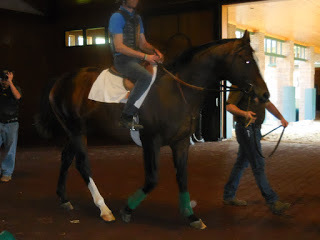
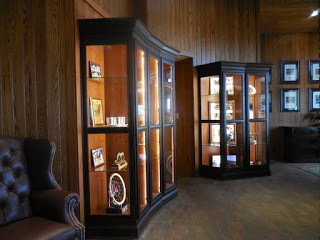 The owner's lounge
The owner's lounge
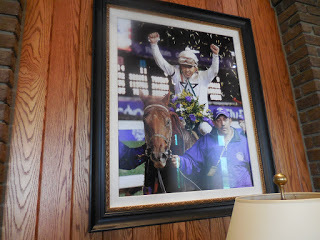 American Pharaoh was bred here.
American Pharaoh was bred here.
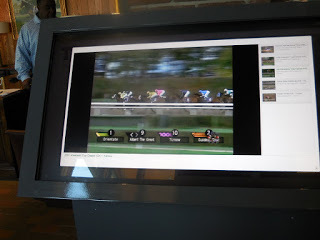
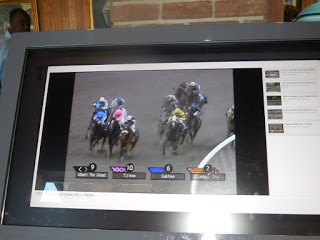 Significant replays available
Significant replays available
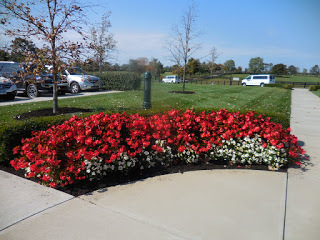 Manicured grounds
Manicured grounds
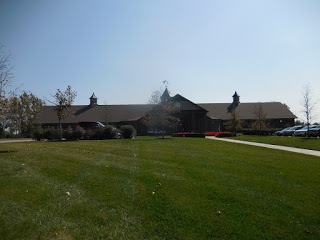
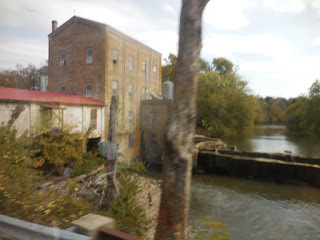 Passing an old mill
Passing an old mill
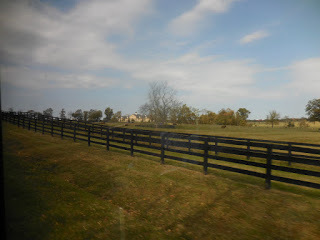
At the second farm, KatieRich, (website here) we mixed with mares, yearlings, and weanlings
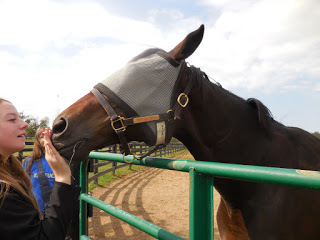 Many of the horses in the pastures worse fly-protection gear. They can see though the screen and not be bothered by the pests.
Many of the horses in the pastures worse fly-protection gear. They can see though the screen and not be bothered by the pests.
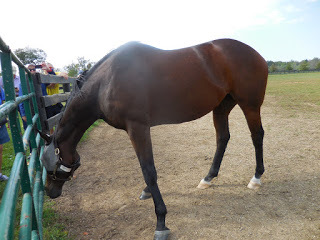
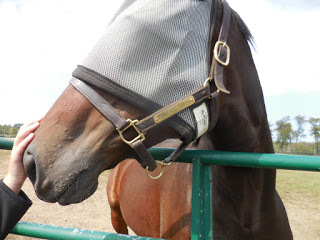
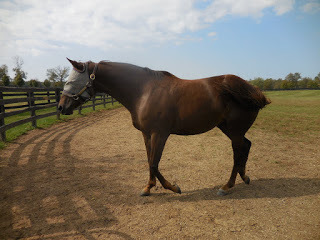
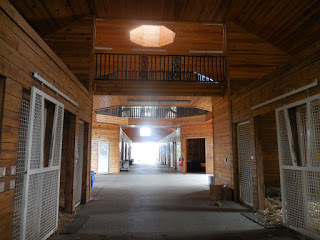 Another pristine facility.
Another pristine facility.
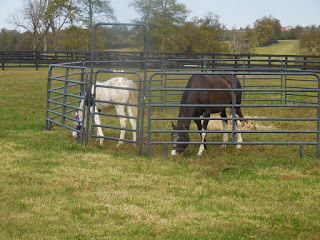
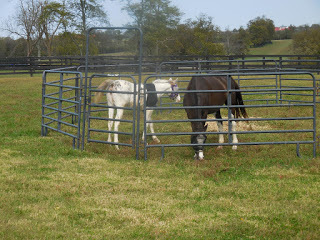
We wished we could get close to this adorable white colt.
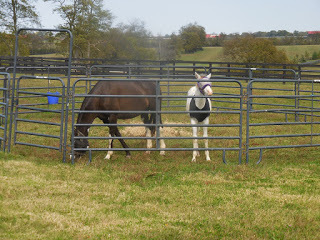
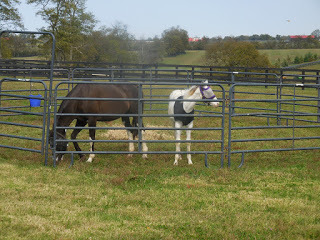
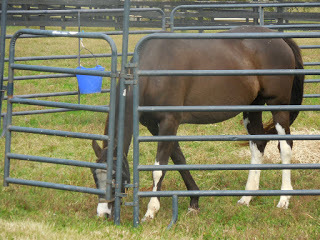
The fields were full of mares whose babes had been recently weaned.
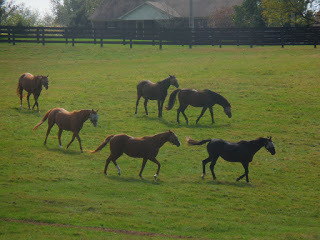
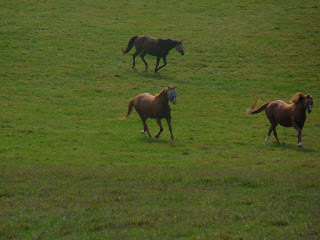
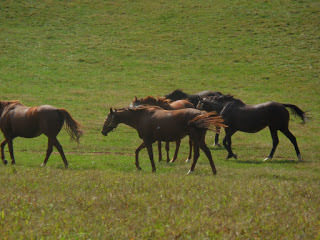
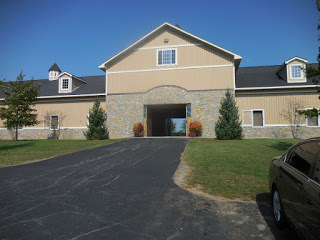 Farm
Farm
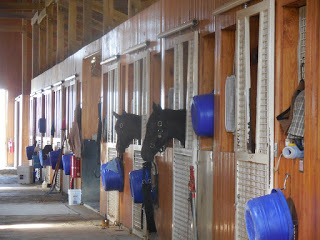 A barn full of yearlings and two-year olds
A barn full of yearlings and two-year olds
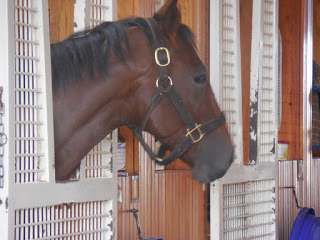
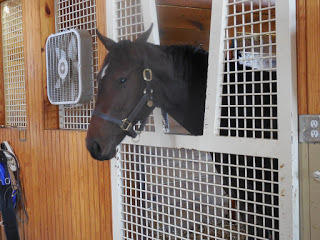
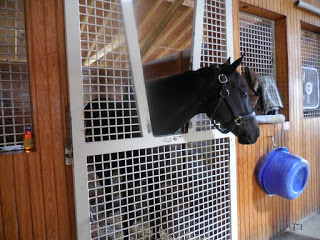
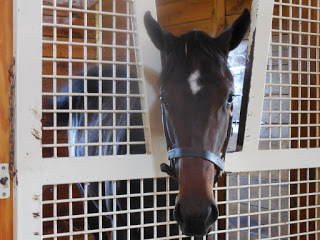
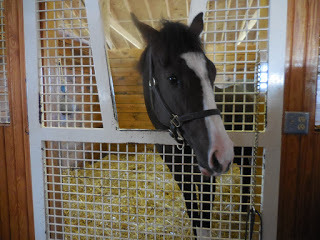
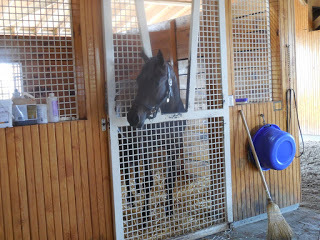
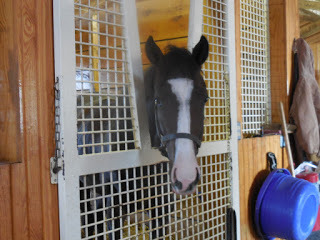
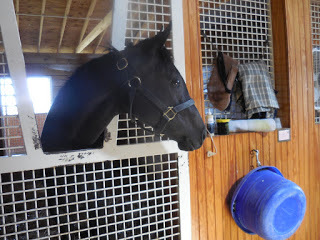
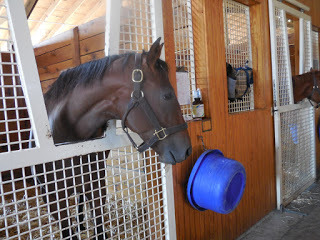
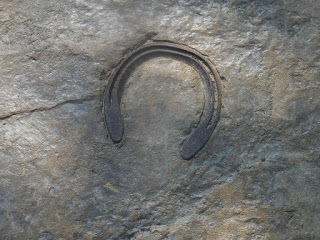
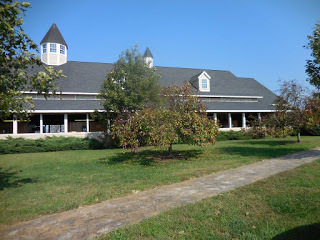
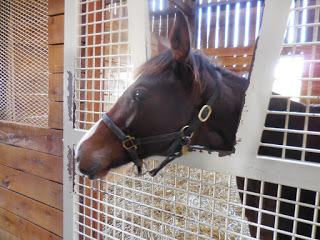
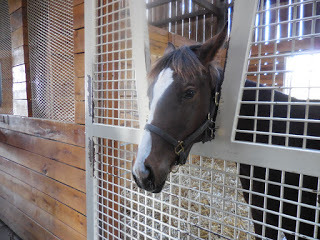
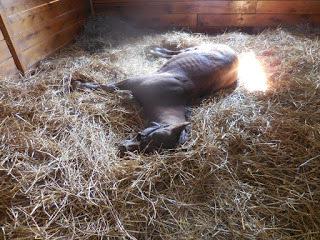 More nappers
More nappers
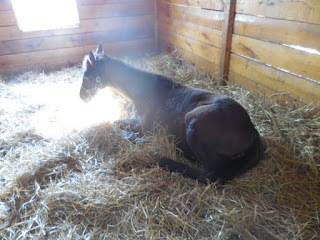
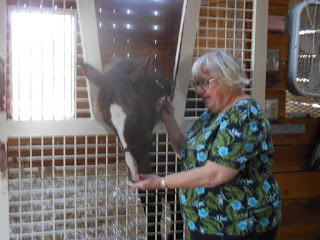 I was in my element
I was in my element
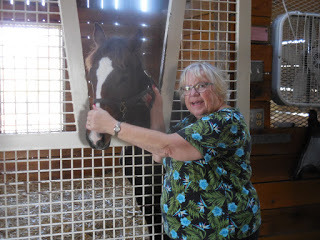
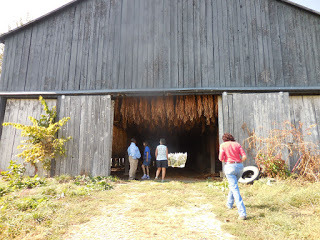
Shawn took us to an old tobacco barn full of the crop, but he said they number of such barns had greatly diminished in the past few years.
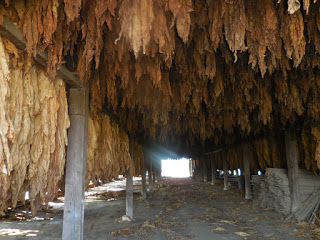
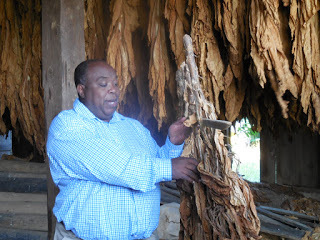 Shawn and the nasty weed
Shawn and the nasty weed
It was a perfect day for the horse-loving teen in me!!!
 Outside the Galt House Hotel, you'd know you were in Kentucky even if the surrounding architecture looked like the picture below.
Outside the Galt House Hotel, you'd know you were in Kentucky even if the surrounding architecture looked like the picture below.
As we drove from Louisville toward Lexington, I regressed a few years back to my horse-crazy days...as a pre-teen and teen, when about the only thing I wanted to do was ride -- or even muck out the stalls. So by the time we arrived at the Kentucky Horse Park, I had become age 13. At least as concerned horses -- I doubt I'd ever want to experience high school all over again. Would you??
 A bit over an hour from Louisville on the edge of Lexingtonis the Kentucky Horse Park, right in the enter of the Bluegrass Region.
A bit over an hour from Louisville on the edge of Lexingtonis the Kentucky Horse Park, right in the enter of the Bluegrass Region. Many statues about, these of frolicking colts
Many statues about, these of frolicking colts Secretariat, 1970-1989Winner of the 1983 Triple Crown
Secretariat, 1970-1989Winner of the 1983 Triple Crown Above and below, Man O'War
Above and below, Man O'War

 Unnamed prancer
Unnamed prancer Skeletons of man and horse, paired for eons
Skeletons of man and horse, paired for eons How horses began their travel by sea
How horses began their travel by sea  Miniature Hackneys
Miniature Hackneys Old Stagecoach
Old Stagecoach A selection of the many trophies won by the iconic Calumet Farms
A selection of the many trophies won by the iconic Calumet Farms A section of the museum was devoted to the Arabian Horse: flourishing today all over the world and founding breed of many other contemporary breeds
A section of the museum was devoted to the Arabian Horse: flourishing today all over the world and founding breed of many other contemporary breeds The three founders of the thoroughbred: The Byerly Turk, the Darley Arabian and the Godolphin Arabian.
The three founders of the thoroughbred: The Byerly Turk, the Darley Arabian and the Godolphin Arabian.
 Bedouins are famous for the care of their horses
Bedouins are famous for the care of their horses Was this one of your favorites in your teens?? Oh, Walter Farley, you are in part responsible for my career in writing!!
Was this one of your favorites in your teens?? Oh, Walter Farley, you are in part responsible for my career in writing!! A Corning Buggy, 1900
A Corning Buggy, 1900Developed in New York in about 1875 for two persons. Often used as a doctor's country vehuicle.
 American Saddlebred
American Saddlebred
Just so you know, there are many live horses around, not just statues and museum displays.




A picture of my teen favorite, the five-gaited champion Wing Commander;painting by Gwen Reardon, 1971
 A five-gated statue or more correctly, a statue of a five-gaited horse
A five-gated statue or more correctly, a statue of a five-gaited horse

My husband was game for a tour of nearby horse farms, and we took off with about 14 companions and our guide, Shawn -- he was the best! He explained that the Horse Park and most of the Bluegrass farms had changed from white fences to black. Why? Because they have to be painted less frequently and save a lot of money. After all, though lots of starry-eyed girls like me would never consider such a thing, breeding and training horses is a business.

 Our guide Shawn, from Unique Horse Farm Tours
Our guide Shawn, from Unique Horse Farm ToursOur first stop was Windstar Farm (website here) where more than twenty stallions stand at stud.
 This fine barn houses only stallions, in the ultimate equine luxury
This fine barn houses only stallions, in the ultimate equine luxury Tiznow
Tiznow I just wasn't quick enough to catch this fine fellow in time!
I just wasn't quick enough to catch this fine fellow in time! This is Pioneer of the Nile, sire of 2015 Triple Crown winner and Breeders Cup champ, American Pharaoh.
This is Pioneer of the Nile, sire of 2015 Triple Crown winner and Breeders Cup champ, American Pharaoh.
 Each stallion gets his daily exercise and constant coddling.
Each stallion gets his daily exercise and constant coddling. Afternoon nap
Afternoon nap
 The stalls are spacious and the horses are treated better than lots of humans!
The stalls are spacious and the horses are treated better than lots of humans!
 The owner's lounge
The owner's lounge American Pharaoh was bred here.
American Pharaoh was bred here.
 Significant replays available
Significant replays available Manicured grounds
Manicured grounds
 Passing an old mill
Passing an old mill
At the second farm, KatieRich, (website here) we mixed with mares, yearlings, and weanlings
 Many of the horses in the pastures worse fly-protection gear. They can see though the screen and not be bothered by the pests.
Many of the horses in the pastures worse fly-protection gear. They can see though the screen and not be bothered by the pests.


 Another pristine facility.
Another pristine facility.

We wished we could get close to this adorable white colt.



The fields were full of mares whose babes had been recently weaned.



 Farm
Farm A barn full of yearlings and two-year olds
A barn full of yearlings and two-year olds












 More nappers
More nappers
 I was in my element
I was in my element

Shawn took us to an old tobacco barn full of the crop, but he said they number of such barns had greatly diminished in the past few years.

 Shawn and the nasty weed
Shawn and the nasty weedIt was a perfect day for the horse-loving teen in me!!!
Published on November 30, 2015 00:30
November 27, 2015
THE DUKE OF WELLINGTON TOUR: A DAY OUT IN WINDSOR
As our coach drew into Windsor, our tour group was greeted by the sight of draft horses delivering beer to a nearby pub. From that moment, we knew that our visit to Windsor would be something special, and I'm glad to say that it was, indeed.
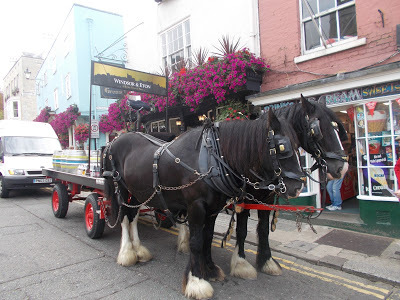
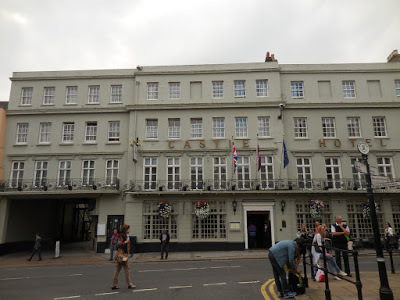
Our group stayed at the Castle Hotel, above, where Victoria and I had both stayed before and which is a personal favourite. The hotel is directly across from some of Windsor's landmarks, including the Guildhall, below, and the Crooked House.
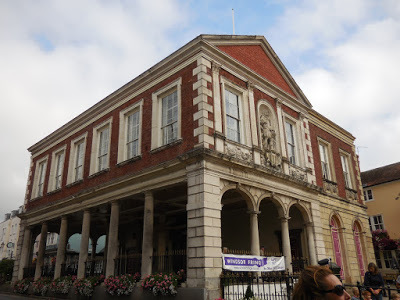
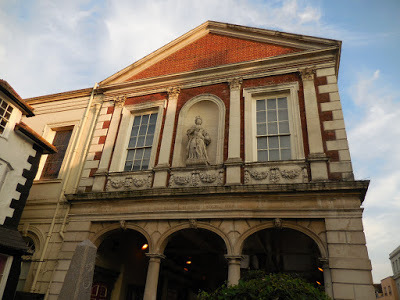
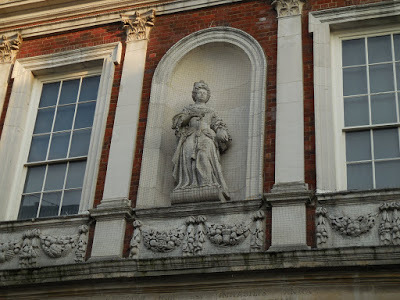
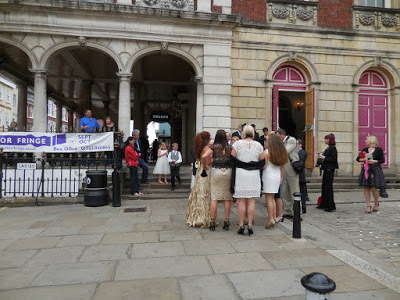
A Guildhall wedding, above, a la Prince Charles and Camilla, who were married here in 2005.
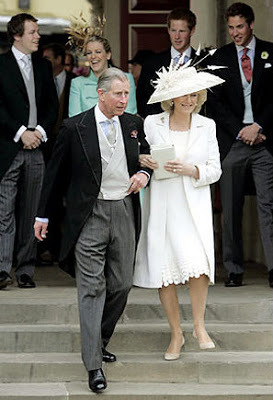
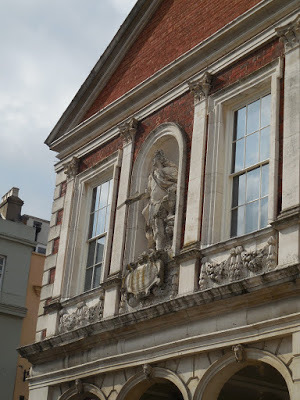
Side view of the Guildhall with statue of George of Denmark, Queen Anne's consort
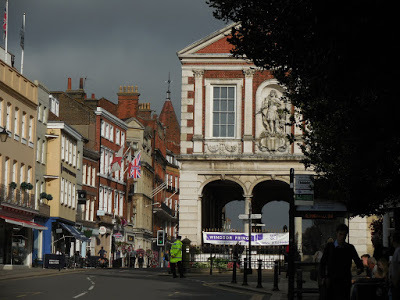
Click here for a tour of the inside of the Guildhall and the history of the building, which we covered in a prior post.
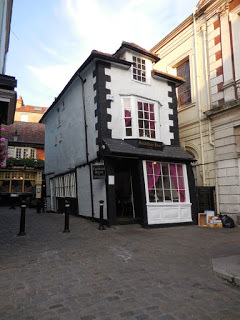
Windsor's Crooked House, built in 1592 and reputed to have a secret passage in the basement leading to Windsor Castle that facilitated trysts between Charles II and Nell Gwynn.
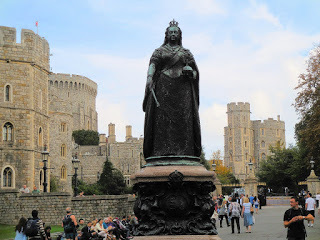
The statue of Queen Victoria which stands at the end of the street leading to the Castle.
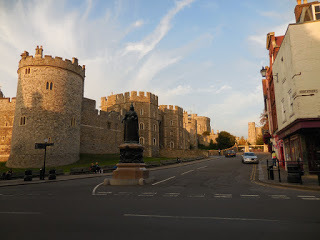
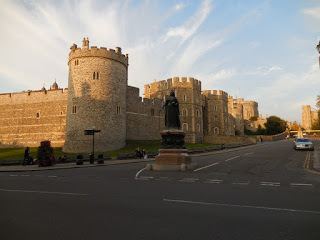
It was a glorious day for our group visit to the Castle.
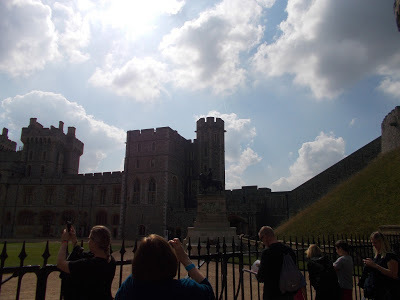
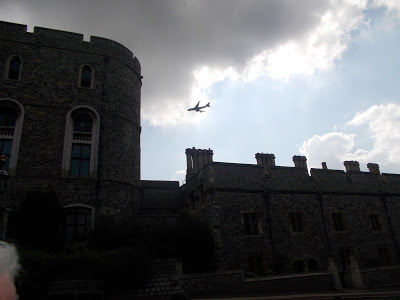
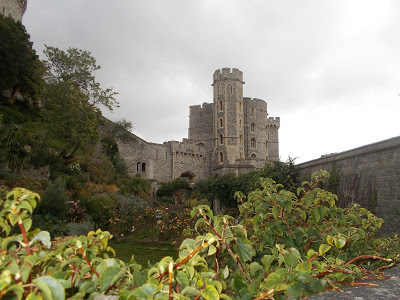
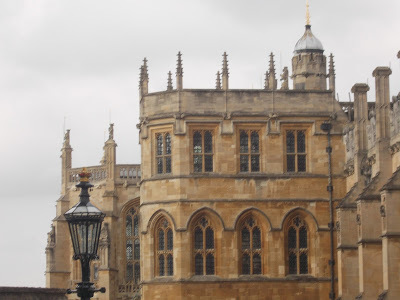
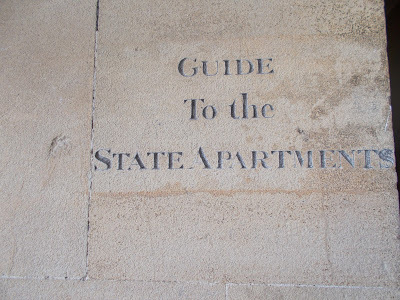
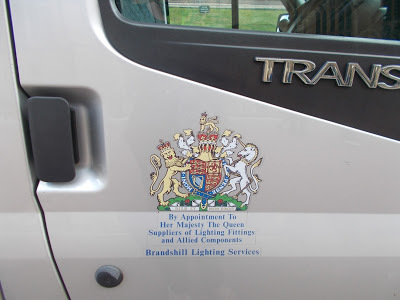
We even got a peek at the van belonging to "Her Majesty's Supplier of Lighting Fittings and Allied Components."
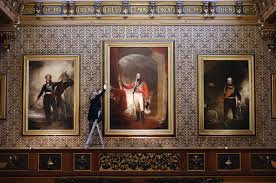
You can read Victoria's prior post on the Waterloo Chamber at Windsor Castle here.
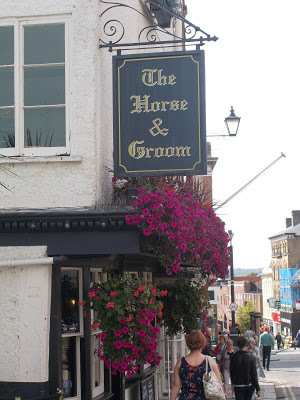
After our tour of the Castle, a pub lunch was enjoyed at The Horse and Groom, the very same pub that received the delivery of ale courtesy of the draft horses.
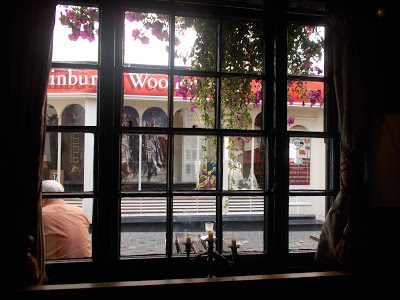
Our table afforded us a birdseye view of the Town, but unfortunately we didn't get a glimpse of the Guard's Band that day - these photos were taken a few days later by Victoria during our extended stay after the conclusion of the Tour.
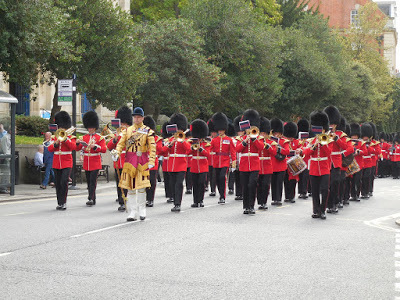
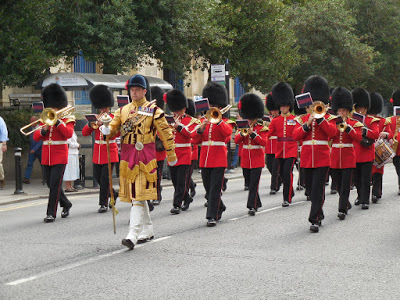
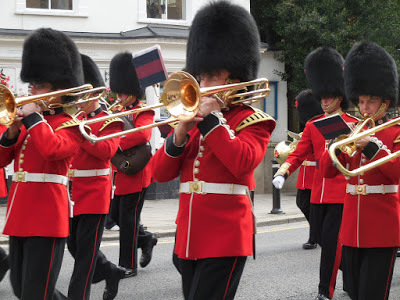
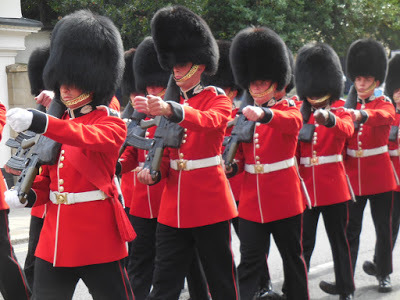
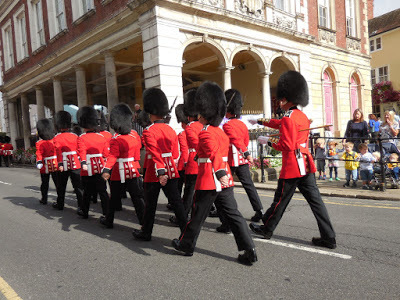
More on our stay in Windsor coming soon!


Our group stayed at the Castle Hotel, above, where Victoria and I had both stayed before and which is a personal favourite. The hotel is directly across from some of Windsor's landmarks, including the Guildhall, below, and the Crooked House.




A Guildhall wedding, above, a la Prince Charles and Camilla, who were married here in 2005.


Side view of the Guildhall with statue of George of Denmark, Queen Anne's consort

Click here for a tour of the inside of the Guildhall and the history of the building, which we covered in a prior post.

Windsor's Crooked House, built in 1592 and reputed to have a secret passage in the basement leading to Windsor Castle that facilitated trysts between Charles II and Nell Gwynn.

The statue of Queen Victoria which stands at the end of the street leading to the Castle.


It was a glorious day for our group visit to the Castle.






We even got a peek at the van belonging to "Her Majesty's Supplier of Lighting Fittings and Allied Components."

You can read Victoria's prior post on the Waterloo Chamber at Windsor Castle here.

After our tour of the Castle, a pub lunch was enjoyed at The Horse and Groom, the very same pub that received the delivery of ale courtesy of the draft horses.

Our table afforded us a birdseye view of the Town, but unfortunately we didn't get a glimpse of the Guard's Band that day - these photos were taken a few days later by Victoria during our extended stay after the conclusion of the Tour.





More on our stay in Windsor coming soon!
Published on November 27, 2015 00:30
November 25, 2015
AT AUCTION: SELECTED ITEMS FROM HOOTON PAGNELL HALL
All the magic of an English Country House sale will come to town when Bonhams auctions the selected contents of Hooton Pagnell Hall in London on Tuesday 1 December.
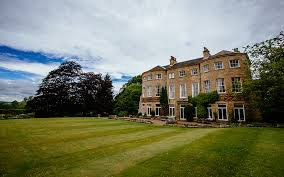
View the video of the history of Hooton Pagnell Hall and it's collections here.
Hooton Pagnell Hall is one of Yorkshire's most important and oldest country houses with a history stretching back to the Doomsday Book. It has been home to the Warde family for more than 300 years. Over the centuries successive generations have added their stamp and the house is a treasure trove of objects.Now the current owner and ninth generation of the family to live at Hooton Pagnell Hall, Mark Warde-Norbury, has decided to sell a selection of the contents. As he explained to the arts journalist Philippa Stockley writing in the winter edition of Bonhams Magazine: "we have five grand pianos and six grandfather clocks. We have to clear some things out in order to move forward.""This sale has everything you'd expect from an English Country House sale", says Bonhams Director of Valuations, Harvey Cammell. "An important view of Windsor Castle, for example, by the renowned watercolourist Paul Sandby; a gruesome - and still functioning - man trap used in the 19th century to deter poachers; a truly remarkable Pietra Dura marble chest inlaid with exquisite birds and vases of lilies brought back from the Grand Tour; and correspondence from the Lady with the Lamp - Florence Nightingale - and the Iron Duke himself the Duke of Wellington."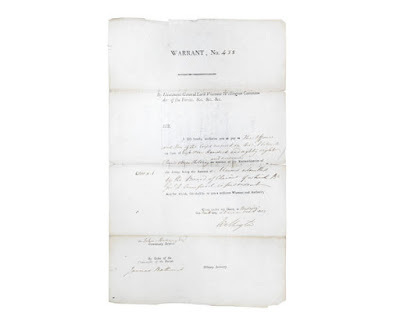
Among the most fascinating items are letters to the explorer and scientist Edward Wilson who reached the South Pole with Captain Scott in 1912 only to die with the rest of the party on the return journey. The owners had a close association with Wilson through his brother who was the Hall's estate manager. A poignant letter to him from Julia Warde-Aldam wishing him a safe return, sent after his death but before the news of the tragedy was known, is included in the sale together with rare first editions of the polar expeditions of Scott and Shackleton.Julia Warde-Aldam was also at the center of Hooton Pagnell Hall's role during World War I when, like so many country houses, it was converted into a hospital and convalescence home. Several items in the sale attest to that melancholy period in the Hall's history none more so perhaps than the crewel work bedspread made for her by a grateful patient with the words: 'LOVINLY WORKED FOR MRS WARDE-ALDAM BY LK BEGUN IN 1913 FINISHED IN THE YEAR OF PEACE 1919.' Mrs Warde-Aldam received many gifts at this time including a large stuffed crocodile.The sale consists of more than 600 lots. It will be held at Bonhams Knightsbridge on 1 December and available to view there from Saturday 28th November.
View the catalogue here.
Details of items mentioned in the text:Windsor castle from the Thames with figures in the foreground by Paul Sandby (1730-1809), £40,000-60,000.An Italian 17th century ebony, pietra dura and specimen marble cabinet, £20,000-30,000.Warrant document signed by the Duke of Wellington, £200-300.Handwritten letter from Florence Nightingale, £400-600.First edition of Scott's Last Expedition, 2 vol., including correspondence from Edward Wilson, £2,000-3,000.Scott's The Voyage of the Discovery, 2 vol., £1,000-1,500.Ernest Shackleton, The Heart of the Antarctic. Being the Story of the British Antarctic Expedition 1907-1909, 3 vol., £8,000-12,000.South Polar Times, vol. 1-2 edited by Shackleton, £5,000-7,000.A 19th century iron mantrap, with eighteen inch jaws and a tilting footplate, £400-600.An early 20th century crewel work bedspread, £400-600.

View the video of the history of Hooton Pagnell Hall and it's collections here.
Hooton Pagnell Hall is one of Yorkshire's most important and oldest country houses with a history stretching back to the Doomsday Book. It has been home to the Warde family for more than 300 years. Over the centuries successive generations have added their stamp and the house is a treasure trove of objects.Now the current owner and ninth generation of the family to live at Hooton Pagnell Hall, Mark Warde-Norbury, has decided to sell a selection of the contents. As he explained to the arts journalist Philippa Stockley writing in the winter edition of Bonhams Magazine: "we have five grand pianos and six grandfather clocks. We have to clear some things out in order to move forward.""This sale has everything you'd expect from an English Country House sale", says Bonhams Director of Valuations, Harvey Cammell. "An important view of Windsor Castle, for example, by the renowned watercolourist Paul Sandby; a gruesome - and still functioning - man trap used in the 19th century to deter poachers; a truly remarkable Pietra Dura marble chest inlaid with exquisite birds and vases of lilies brought back from the Grand Tour; and correspondence from the Lady with the Lamp - Florence Nightingale - and the Iron Duke himself the Duke of Wellington."

Among the most fascinating items are letters to the explorer and scientist Edward Wilson who reached the South Pole with Captain Scott in 1912 only to die with the rest of the party on the return journey. The owners had a close association with Wilson through his brother who was the Hall's estate manager. A poignant letter to him from Julia Warde-Aldam wishing him a safe return, sent after his death but before the news of the tragedy was known, is included in the sale together with rare first editions of the polar expeditions of Scott and Shackleton.Julia Warde-Aldam was also at the center of Hooton Pagnell Hall's role during World War I when, like so many country houses, it was converted into a hospital and convalescence home. Several items in the sale attest to that melancholy period in the Hall's history none more so perhaps than the crewel work bedspread made for her by a grateful patient with the words: 'LOVINLY WORKED FOR MRS WARDE-ALDAM BY LK BEGUN IN 1913 FINISHED IN THE YEAR OF PEACE 1919.' Mrs Warde-Aldam received many gifts at this time including a large stuffed crocodile.The sale consists of more than 600 lots. It will be held at Bonhams Knightsbridge on 1 December and available to view there from Saturday 28th November.
View the catalogue here.
Details of items mentioned in the text:Windsor castle from the Thames with figures in the foreground by Paul Sandby (1730-1809), £40,000-60,000.An Italian 17th century ebony, pietra dura and specimen marble cabinet, £20,000-30,000.Warrant document signed by the Duke of Wellington, £200-300.Handwritten letter from Florence Nightingale, £400-600.First edition of Scott's Last Expedition, 2 vol., including correspondence from Edward Wilson, £2,000-3,000.Scott's The Voyage of the Discovery, 2 vol., £1,000-1,500.Ernest Shackleton, The Heart of the Antarctic. Being the Story of the British Antarctic Expedition 1907-1909, 3 vol., £8,000-12,000.South Polar Times, vol. 1-2 edited by Shackleton, £5,000-7,000.A 19th century iron mantrap, with eighteen inch jaws and a tilting footplate, £400-600.An early 20th century crewel work bedspread, £400-600.
Published on November 25, 2015 00:00
November 23, 2015
IS IT JANUARY YET?!
Each year, it seems as though time speeds up at the end of September. Before we know it, Halloween is upon us and before you know it, we're shopping for Thanksgiving turkeys and then its on to Christmas shopping, tree buying and decorating and suddenly it's New Years Eve. Caught up in the warp speed of time myself, I'm not trying to rush things further, but really - is it January yet? There are so many good things coming to telly that it's hard to be patient.
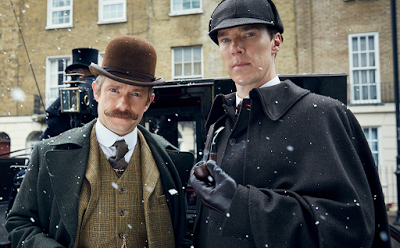
Of course, topping the list as my personal favourite is the Sherlock Christmas Special. Not only will Sherlock, John, Mrs. Hudson and Mary return, but they'll be in Victorian London - Huzza! The holiday special, The Abominable Bride, will air on Friday, January 1, 2016 in both the US and the UK - Happy New Year, indeed.
From an October 24, 2015 RadioTimes article:
Sherlock creators Mark Gatiss and Steven Moffat have a history of taking the titles of original Arthur Conan Doyle stories and putting a spin on them. A Study in Scarlet became A Study in Pink, The Sign of Four became The Sign of Three and the Empty House became The Empty Hearse. Meanwhile, they’ve also given cheeky nods to cases that are mentioned in passing by the original Sherlock Holmes and Dr Watson but were never actually written, such as the giant rat of Sumatra and the Aluminium Crutch.What they haven’t done is put the two together – until now…As Mark Gatiss told us when he revealed the title of the Victorian-themed Sherlock special, The Abominable Bride, at London ComicCon on Saturday, it's inspired by Holmes's throwaway reference to the case of "Ricoletti of the club foot and his abominable wife".The mention comes during the Sherlock Holmes short story The Musgrave Ritual, which begins with Holmes sorting through some old case files with Watson.“Here's the record of the Tarleton murders and the case of Vamberry, the wine merchant, and the adventure of the old Russian woman, and the singular affair of the aluminium crutch, as well as a full account of Ricoletti of the club foot and his abominable wife," says the detective.And that's pretty much that, meaning that we know almost nothing about Ricoletti and his wife – beyond the fact that he had a club foot and she was, apparently, abominable.It looks fabulous, as you'll see for yourself by watching the official trailer here. So nice to know that the game will soon be afoot once more.
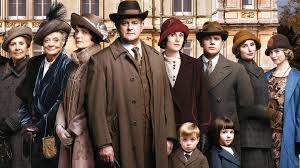
Next up is the final season of Downton Abbey airing in the US on Sunday, January 4, 2016. As the photo above demonstrates, everyone's got their coats on, but where are they all going? It appears that we'll have to wait and see.
You'll find a fabulous five minute long video compilation of the best of the past five seasons ending with a teaser for the final season here.
The cast members become emotional as they discuss filming the final scenes in this clip.
If you need to need to be reminded of why we love the Dowager Countess, watch this.
PBS offers a slideshow of photos highlighting scenes from the final season here.
And if you can bear it, watch the Downton Abbey Final Episode Trailer here.

Finally, Ricky Gervais will return as host of the 73rd Annual Golden Globes on January 10, 2016 which, depending on your personal preference, can either be a good thing or a bad thing. As Variety reported:
“We’re excited to have Ricky Gervais back to host the most enjoyable awards show of the season in his own inimitable way,” said NBC Entertainment chairman Robert Greenblatt in a statement. “Disarming and surprising, Ricky is ready to honor — and send up — the best work of the year in film and television. Fasten your seats belts.”Gervais, who hosted the Globes for three consecutive years from 2010-2012, will take over for co-hosts Tina Fey and Amy Poehler, who also saw a three-year stint.The Emmy-winning star of “The Office” and Netflix’s “Derek” had previously sworn off hosting the Globes again after his controversial jokes, which included a dig at Jodie Foster’s sexuality, raised a few eyebrows at the Beverly Hilton ceremony.“Actors aren’t just loved here in Hollywood, they are loved the world over,” he said in 2012, holding one of his trademark pints of beer. “You could be a little Asian child with no possessions and no money. But you could see a picture of Angelina Jolie and you’d think, ‘Mummy!’”Gervais later responded to the backlash by saying, “I’ve told my agent to never let me be persuaded to do it again though. It’s like a parachute jump.”But his final hosting stint drew mostly positive reviews and nearly 17 million viewers, which NBC noted in its press release.You be the judge - here's a clip of Gervais's opening monologue from the 2011 Golden Globes.

Of course, topping the list as my personal favourite is the Sherlock Christmas Special. Not only will Sherlock, John, Mrs. Hudson and Mary return, but they'll be in Victorian London - Huzza! The holiday special, The Abominable Bride, will air on Friday, January 1, 2016 in both the US and the UK - Happy New Year, indeed.
From an October 24, 2015 RadioTimes article:
Sherlock creators Mark Gatiss and Steven Moffat have a history of taking the titles of original Arthur Conan Doyle stories and putting a spin on them. A Study in Scarlet became A Study in Pink, The Sign of Four became The Sign of Three and the Empty House became The Empty Hearse. Meanwhile, they’ve also given cheeky nods to cases that are mentioned in passing by the original Sherlock Holmes and Dr Watson but were never actually written, such as the giant rat of Sumatra and the Aluminium Crutch.What they haven’t done is put the two together – until now…As Mark Gatiss told us when he revealed the title of the Victorian-themed Sherlock special, The Abominable Bride, at London ComicCon on Saturday, it's inspired by Holmes's throwaway reference to the case of "Ricoletti of the club foot and his abominable wife".The mention comes during the Sherlock Holmes short story The Musgrave Ritual, which begins with Holmes sorting through some old case files with Watson.“Here's the record of the Tarleton murders and the case of Vamberry, the wine merchant, and the adventure of the old Russian woman, and the singular affair of the aluminium crutch, as well as a full account of Ricoletti of the club foot and his abominable wife," says the detective.And that's pretty much that, meaning that we know almost nothing about Ricoletti and his wife – beyond the fact that he had a club foot and she was, apparently, abominable.It looks fabulous, as you'll see for yourself by watching the official trailer here. So nice to know that the game will soon be afoot once more.

Next up is the final season of Downton Abbey airing in the US on Sunday, January 4, 2016. As the photo above demonstrates, everyone's got their coats on, but where are they all going? It appears that we'll have to wait and see.
You'll find a fabulous five minute long video compilation of the best of the past five seasons ending with a teaser for the final season here.
The cast members become emotional as they discuss filming the final scenes in this clip.
If you need to need to be reminded of why we love the Dowager Countess, watch this.
PBS offers a slideshow of photos highlighting scenes from the final season here.
And if you can bear it, watch the Downton Abbey Final Episode Trailer here.

Finally, Ricky Gervais will return as host of the 73rd Annual Golden Globes on January 10, 2016 which, depending on your personal preference, can either be a good thing or a bad thing. As Variety reported:
“We’re excited to have Ricky Gervais back to host the most enjoyable awards show of the season in his own inimitable way,” said NBC Entertainment chairman Robert Greenblatt in a statement. “Disarming and surprising, Ricky is ready to honor — and send up — the best work of the year in film and television. Fasten your seats belts.”Gervais, who hosted the Globes for three consecutive years from 2010-2012, will take over for co-hosts Tina Fey and Amy Poehler, who also saw a three-year stint.The Emmy-winning star of “The Office” and Netflix’s “Derek” had previously sworn off hosting the Globes again after his controversial jokes, which included a dig at Jodie Foster’s sexuality, raised a few eyebrows at the Beverly Hilton ceremony.“Actors aren’t just loved here in Hollywood, they are loved the world over,” he said in 2012, holding one of his trademark pints of beer. “You could be a little Asian child with no possessions and no money. But you could see a picture of Angelina Jolie and you’d think, ‘Mummy!’”Gervais later responded to the backlash by saying, “I’ve told my agent to never let me be persuaded to do it again though. It’s like a parachute jump.”But his final hosting stint drew mostly positive reviews and nearly 17 million viewers, which NBC noted in its press release.You be the judge - here's a clip of Gervais's opening monologue from the 2011 Golden Globes.
Published on November 23, 2015 00:30
November 20, 2015
WHAT KRISTINE SAW FROM THE WINDOWS: BASILDON PARK
Published on November 20, 2015 00:30
November 18, 2015
JANE AUSTEN'S BIRTHDAY CELEBRATION A LITTLE EARLY
JANE AUSTEN'S BIRTHDAY CELEBRATION A LITTLE EARLY...
Yes, JASNA-WI pushed ahead a month or so so that we could hear the Jane Austen Society of North America's President Claire Bellanti address us. The weather cooperated and it was a sunny and warm day for our usually dreary November in Wisconsin. I guess Claire brought her California weather along for the trip.
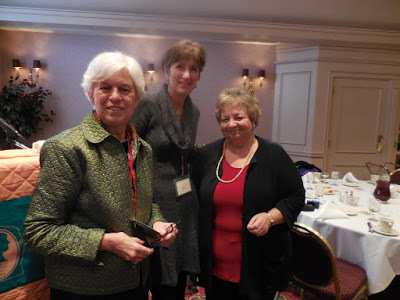 Jane Glaser, Liz Cooper, and Clair Bellanti chat before luncheon
Jane Glaser, Liz Cooper, and Clair Bellanti chat before luncheon
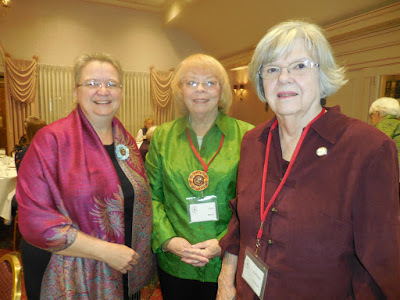 Carolyn Hippert, Regional Coordinator Judith Beine, and Kathleen O'Brien
Carolyn Hippert, Regional Coordinator Judith Beine, and Kathleen O'Brien
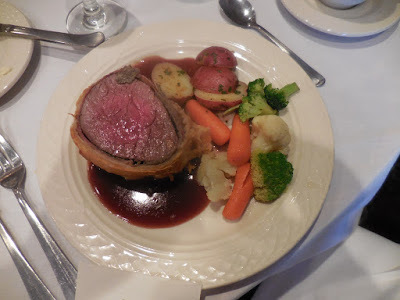 Beef Wellington is always a favorite
Beef Wellington is always a favorite
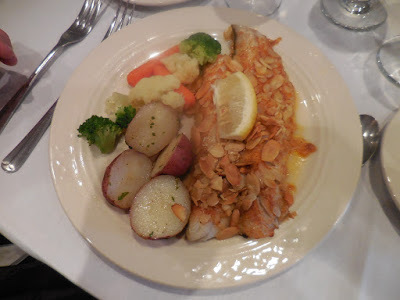 I opted for the Walleyed Pike and it was delicious
I opted for the Walleyed Pike and it was delicious
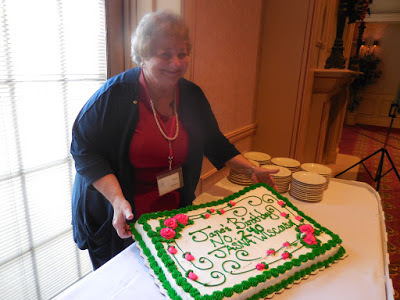 JASNA President Claire Bellanti shows off the cake for Jane's 240th yearthough her actual birthday is not until December 16
JASNA President Claire Bellanti shows off the cake for Jane's 240th yearthough her actual birthday is not until December 16
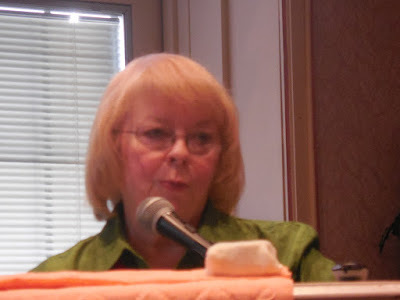 Judy Beine convenes our celebration
Judy Beine convenes our celebration
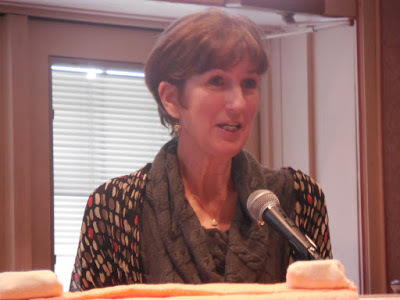 Liz Philosophos Cooper. JASNA Vice President for Regionsintroduced our speaker
Liz Philosophos Cooper. JASNA Vice President for Regionsintroduced our speaker
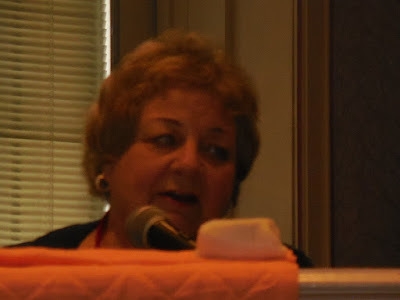 Claire Bellanti told us "You Can Get a Parasol at Whitby's": Circulating Libraries in Jane Austen's Time
Claire Bellanti told us "You Can Get a Parasol at Whitby's": Circulating Libraries in Jane Austen's Time
In her unfinished novel Sanditon, Jane Austen has her characters observe the many fine services offered at the local circulating library as indicative of the prospects for a happy future in the developing seaside resort. Jane and her sister Cassandra used circulating libraries, a major source of reading material for individuals of the late 18th and early 19th centuries. A fee was charged for subscriptions that could be by the year or for shorter periods of time.
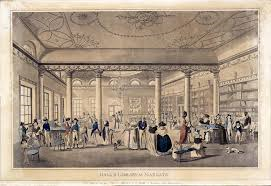 Hall's Circulating Library, Margate
Hall's Circulating Library, Margate
Ms. Bellanti discussed the forces that created the circulating libraries; of course there were no public libraries in Britain in those days. And the costs of paper, printing and binding were high. So the main impetus for the sharing of books was economic. The costs of subscriptions varied widely but were probably no more than the price of one book.
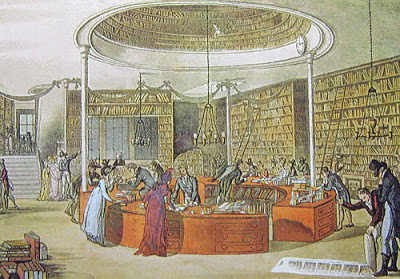 Temple of the Muses, Lackington Allen and Co., Finsbury Square, 1809The above print from Ackermann's Repository of Arts shows the premises of Lackington Allen and Company in the late 18th C. James Lackington's bookshop was one of the illustrious sights of London. The sales and rental of books grew dramatically from the middle of the 18th century as the number of readers grew with the increase in literacy and the widespread use of whale oil lamps to provide evening light suitable for reading, a great improvement over candles.
Temple of the Muses, Lackington Allen and Co., Finsbury Square, 1809The above print from Ackermann's Repository of Arts shows the premises of Lackington Allen and Company in the late 18th C. James Lackington's bookshop was one of the illustrious sights of London. The sales and rental of books grew dramatically from the middle of the 18th century as the number of readers grew with the increase in literacy and the widespread use of whale oil lamps to provide evening light suitable for reading, a great improvement over candles.
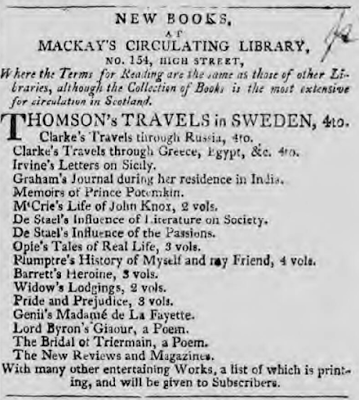 A close look shows you Pride and Prejudice fifth from the bottom of this list.
A close look shows you Pride and Prejudice fifth from the bottom of this list.
Jane Austen's family members were novel readers, but not all persons in the period admired novels in general and particularly the Gothic novels written by many women authors which were very popular. As with today's romance novels, many people look down their noses at the female-centered stories, grouping them all together. A writer of historical romance myself, I must say such people are denying themselves a comforting form of varied entertainment...but that is another lecture for another day!
Ms. Bellanti distributed a list of library references found in Jane Austen's six novels along with Sanditon, the unfinished work. For Austen, the library was an essential of life, and so it was for her characters.
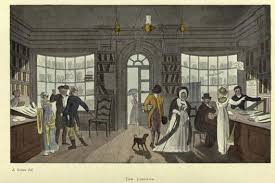 The Circulating Library in Scarborough, c.1818
The Circulating Library in Scarborough, c.1818
In conclusion, Ms. Bellanti suggested that in moving her publication to John Murray in 1816, Jane Austen and Henry Austen may have ensured that her novels were taken seriously, for Murray was a serious and distinguished publisher of fine works of both fiction and nonfiction.
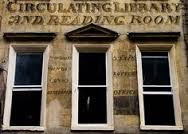 Image from Milsom Street, Bath
Image from Milsom Street, Bath
In honor of the topic of the day, libraries, Susan Flaherty created favors for all with illustrations from Austen;s novels and a "gone but not forgotten" checkout card we all loved to see again.
Great idea, Susan.
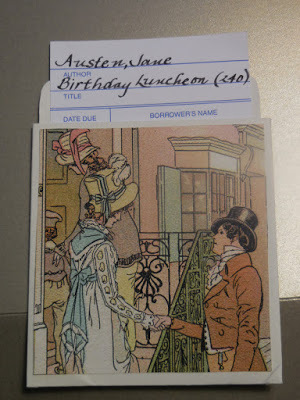
Thank you Claire Bellanti, President of JASNA, for taking the time to share our celebration of our favorite author's 240th birthday.
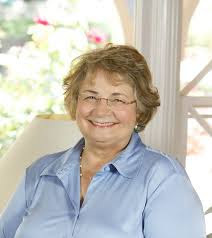 Clair Bellantil JASNA President
Clair Bellantil JASNA President
Yes, JASNA-WI pushed ahead a month or so so that we could hear the Jane Austen Society of North America's President Claire Bellanti address us. The weather cooperated and it was a sunny and warm day for our usually dreary November in Wisconsin. I guess Claire brought her California weather along for the trip.
 Jane Glaser, Liz Cooper, and Clair Bellanti chat before luncheon
Jane Glaser, Liz Cooper, and Clair Bellanti chat before luncheon Carolyn Hippert, Regional Coordinator Judith Beine, and Kathleen O'Brien
Carolyn Hippert, Regional Coordinator Judith Beine, and Kathleen O'Brien Beef Wellington is always a favorite
Beef Wellington is always a favorite I opted for the Walleyed Pike and it was delicious
I opted for the Walleyed Pike and it was delicious JASNA President Claire Bellanti shows off the cake for Jane's 240th yearthough her actual birthday is not until December 16
JASNA President Claire Bellanti shows off the cake for Jane's 240th yearthough her actual birthday is not until December 16 Judy Beine convenes our celebration
Judy Beine convenes our celebration Liz Philosophos Cooper. JASNA Vice President for Regionsintroduced our speaker
Liz Philosophos Cooper. JASNA Vice President for Regionsintroduced our speaker  Claire Bellanti told us "You Can Get a Parasol at Whitby's": Circulating Libraries in Jane Austen's Time
Claire Bellanti told us "You Can Get a Parasol at Whitby's": Circulating Libraries in Jane Austen's Time In her unfinished novel Sanditon, Jane Austen has her characters observe the many fine services offered at the local circulating library as indicative of the prospects for a happy future in the developing seaside resort. Jane and her sister Cassandra used circulating libraries, a major source of reading material for individuals of the late 18th and early 19th centuries. A fee was charged for subscriptions that could be by the year or for shorter periods of time.
 Hall's Circulating Library, Margate
Hall's Circulating Library, MargateMs. Bellanti discussed the forces that created the circulating libraries; of course there were no public libraries in Britain in those days. And the costs of paper, printing and binding were high. So the main impetus for the sharing of books was economic. The costs of subscriptions varied widely but were probably no more than the price of one book.
 Temple of the Muses, Lackington Allen and Co., Finsbury Square, 1809The above print from Ackermann's Repository of Arts shows the premises of Lackington Allen and Company in the late 18th C. James Lackington's bookshop was one of the illustrious sights of London. The sales and rental of books grew dramatically from the middle of the 18th century as the number of readers grew with the increase in literacy and the widespread use of whale oil lamps to provide evening light suitable for reading, a great improvement over candles.
Temple of the Muses, Lackington Allen and Co., Finsbury Square, 1809The above print from Ackermann's Repository of Arts shows the premises of Lackington Allen and Company in the late 18th C. James Lackington's bookshop was one of the illustrious sights of London. The sales and rental of books grew dramatically from the middle of the 18th century as the number of readers grew with the increase in literacy and the widespread use of whale oil lamps to provide evening light suitable for reading, a great improvement over candles. A close look shows you Pride and Prejudice fifth from the bottom of this list.
A close look shows you Pride and Prejudice fifth from the bottom of this list.Jane Austen's family members were novel readers, but not all persons in the period admired novels in general and particularly the Gothic novels written by many women authors which were very popular. As with today's romance novels, many people look down their noses at the female-centered stories, grouping them all together. A writer of historical romance myself, I must say such people are denying themselves a comforting form of varied entertainment...but that is another lecture for another day!
Ms. Bellanti distributed a list of library references found in Jane Austen's six novels along with Sanditon, the unfinished work. For Austen, the library was an essential of life, and so it was for her characters.
 The Circulating Library in Scarborough, c.1818
The Circulating Library in Scarborough, c.1818In conclusion, Ms. Bellanti suggested that in moving her publication to John Murray in 1816, Jane Austen and Henry Austen may have ensured that her novels were taken seriously, for Murray was a serious and distinguished publisher of fine works of both fiction and nonfiction.
 Image from Milsom Street, Bath
Image from Milsom Street, BathIn honor of the topic of the day, libraries, Susan Flaherty created favors for all with illustrations from Austen;s novels and a "gone but not forgotten" checkout card we all loved to see again.
Great idea, Susan.

Thank you Claire Bellanti, President of JASNA, for taking the time to share our celebration of our favorite author's 240th birthday.
 Clair Bellantil JASNA President
Clair Bellantil JASNA President
Published on November 18, 2015 00:00
November 16, 2015
GEORGIAN ART AT THE CINCINNATI ART MUSEUM
GEORGIAN ART AT THE CINCINNATI ART MUSEUM
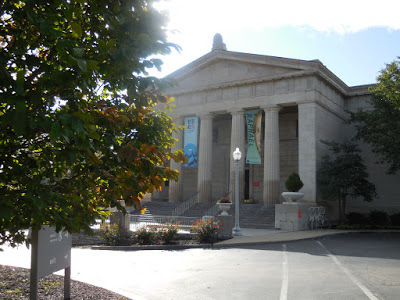 Victoria here. Following the meeting of the Jane Austen Society of North America in Louisville, Ed and I spent a day at the Kentucky Horse Park in Lexington, then drove to Cincinnati. The art museum was a goal of mine for a long time, since they had a fine exhibit of Gainsborough portraits in 2010 that I could not travel to see. So the next day, I decided to take a look!
Victoria here. Following the meeting of the Jane Austen Society of North America in Louisville, Ed and I spent a day at the Kentucky Horse Park in Lexington, then drove to Cincinnati. The art museum was a goal of mine for a long time, since they had a fine exhibit of Gainsborough portraits in 2010 that I could not travel to see. So the next day, I decided to take a look! 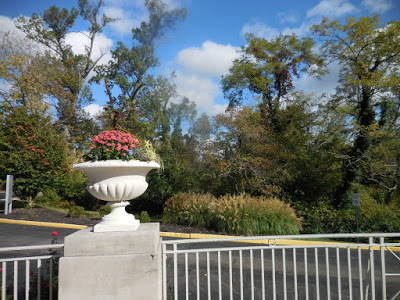 Perfect weather
Perfect weather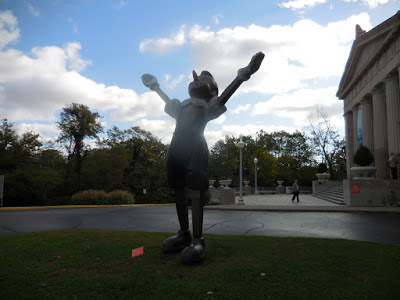 Not exactly Gainsborough -- but Jim Dine's Pinocchio from 2007.
Not exactly Gainsborough -- but Jim Dine's Pinocchio from 2007.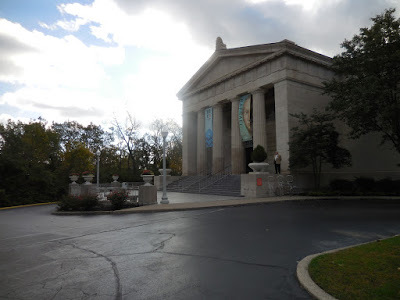 The museum, now greatly expanded, opened in 1886 in Eden Park \
The museum, now greatly expanded, opened in 1886 in Eden Park \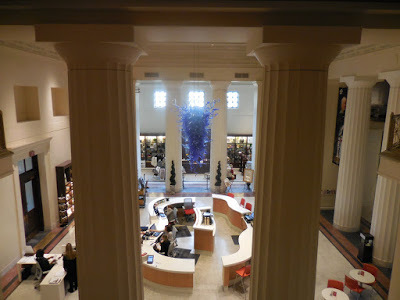 The entrance from above
The entrance from above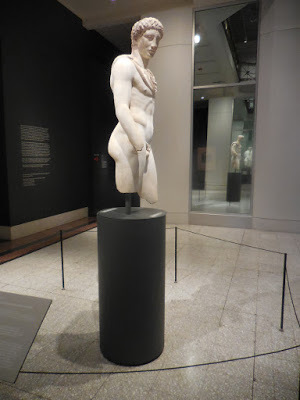 Inside, a statue of a Greek God or Hero, 1st century A.D.
Inside, a statue of a Greek God or Hero, 1st century A.D.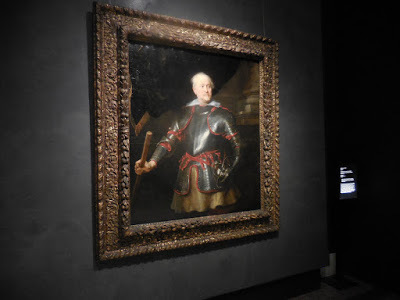 Anthony Van Dyck, Portrait of a Man in Armor, c. 1621-27
Anthony Van Dyck, Portrait of a Man in Armor, c. 1621-27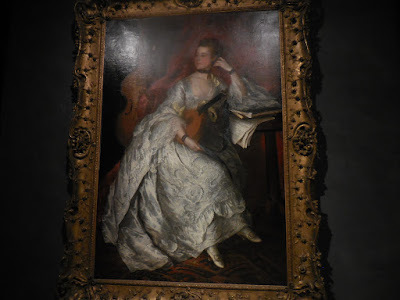 At last, a Gainsborough!Ann Ford, later Mrs. Philip Thicknesse, 1760
At last, a Gainsborough!Ann Ford, later Mrs. Philip Thicknesse, 1760From the text panel: "Thomas Gainsborough, feminist. Conspiring with fashionable ladies of artistic talent, the artist's unconventional portraits of elegant ladies helped to shape the image of the modern woman...The sitter's crossed legs and fashionable dress display a loose style of applying paint that was in opposition to conventional standards of decorum and dress."
Below, the unreflected image from Wikimedia Commons:
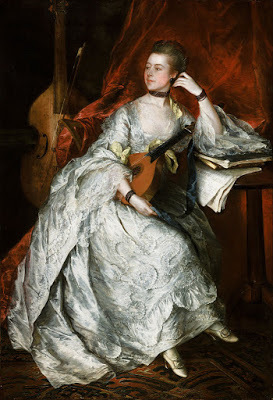
\
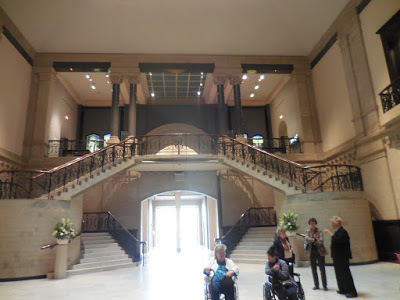
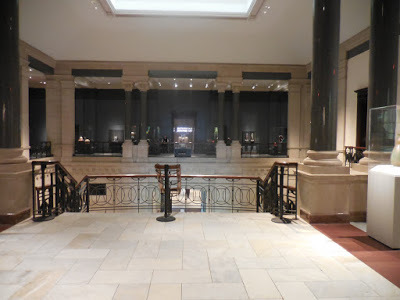
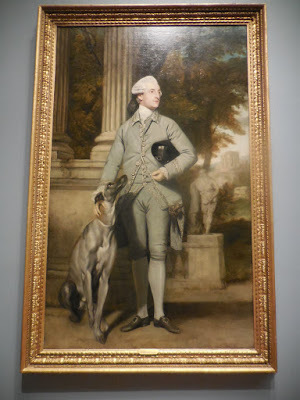 Sir Joshua Reynolds, Richard Peers Symons,M.P. (later Baronet) 1770-71
Sir Joshua Reynolds, Richard Peers Symons,M.P. (later Baronet) 1770-71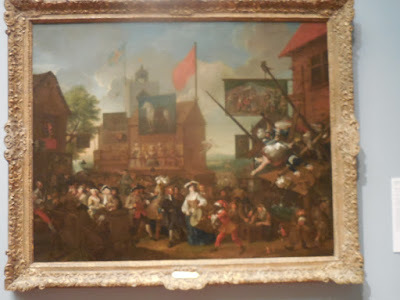 William Hogarth, Southwark Fair, 7133
William Hogarth, Southwark Fair, 7133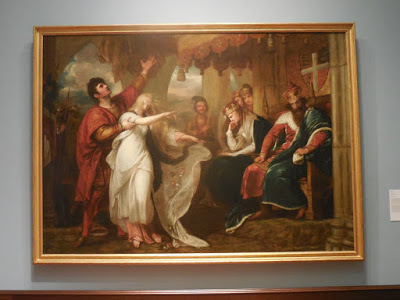 Benjamin West, Ophelia and Laertes, 1792
Benjamin West, Ophelia and Laertes, 1792From the text panel: "West's monumental painting was part of an ambitious plan to mount a permanent exhibit in a London Gallery of paintings depicting all of Shakespeare's plays. The project failed, however, and the paintings were dispersed. ...Oral tradition maintains that the painting was brought down the Ohio River on a flatboat. One of the first paintings to enter the Cincinnati Art Museum..."
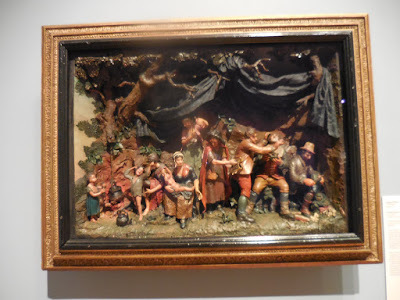 Samuel Percy, Rustic Scene: Gypsy Encampment, c. 1800, polychrome wax
Samuel Percy, Rustic Scene: Gypsy Encampment, c. 1800, polychrome waxSkillful wax modeling in this unusual (to me) scene.
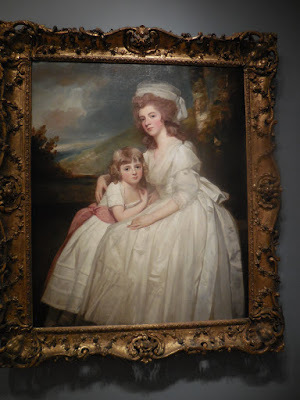 George Romney, Portrait of Mrs. Richard Pryce Corbet and Her Daughter, 1780
George Romney, Portrait of Mrs. Richard Pryce Corbet and Her Daughter, 1780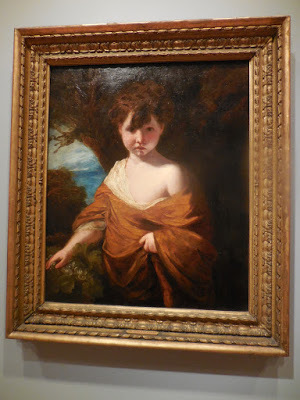 Sir Joshua Reynolds, Boy with Grapes, 1773
Sir Joshua Reynolds, Boy with Grapes, 1773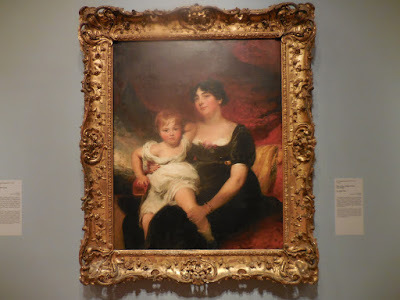 Sir Thomas Lawrence, Mrs. Francis Gregg and her son George, ca. 1805-06
Sir Thomas Lawrence, Mrs. Francis Gregg and her son George, ca. 1805-06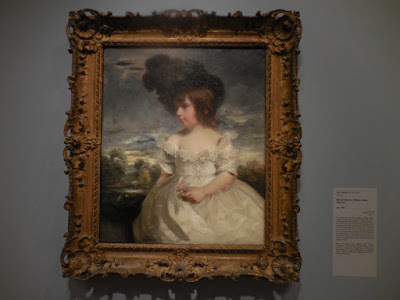 John Hoppner: Master Meyrick (William Henry Meyrick), ca. 1793
John Hoppner: Master Meyrick (William Henry Meyrick), ca. 1793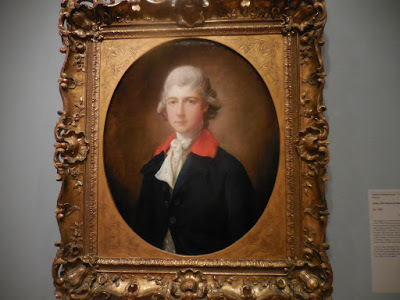 Thomas Gainsborough, John, 5th Viscount Downe, ca. 1791
Thomas Gainsborough, John, 5th Viscount Downe, ca. 1791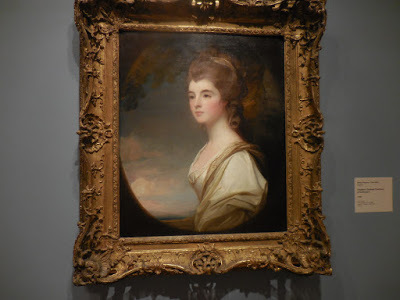 George Romney, Elizabeth, Duchess-Countess of Sutherland, 1782
George Romney, Elizabeth, Duchess-Countess of Sutherland, 1782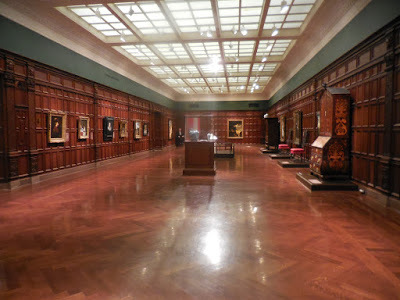
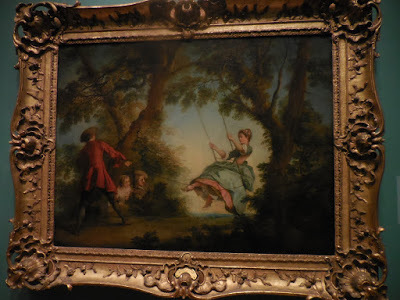 Nicolas Lancret, The Swing, 1730-35
Nicolas Lancret, The Swing, 1730-35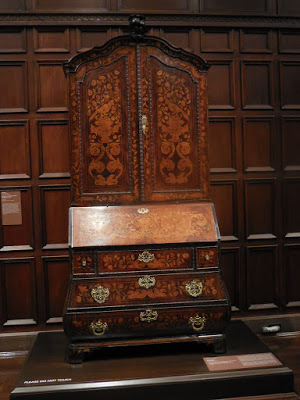 Secretary, mid-18th C, The Netherlands
Secretary, mid-18th C, The NetherlandsBelow, some snaps from the American Decorative Arts Collection.
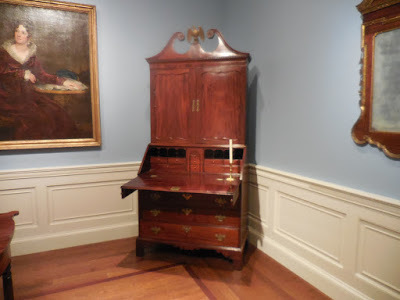 Possibly John Chipman, Secretary, 1785-1800, in the Massachusetts style
Possibly John Chipman, Secretary, 1785-1800, in the Massachusetts style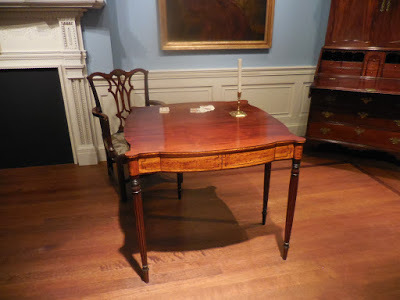 Card Table, circa 1800
Card Table, circa 1800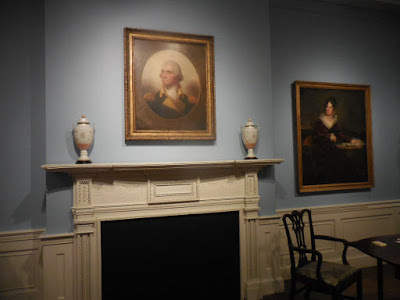 Above the fireplace, Rembrandt Peale, George Washington, c. 1845
Above the fireplace, Rembrandt Peale, George Washington, c. 1845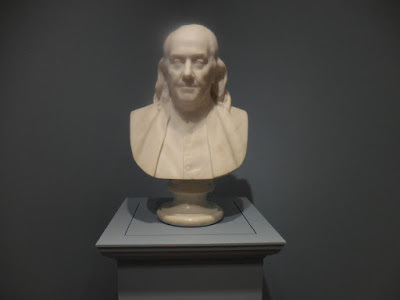 Hiram Powers, Benjamin Franklin, modeled 1848-49, carved after 1850
Hiram Powers, Benjamin Franklin, modeled 1848-49, carved after 1850At least seventeen of these busts were created by Powers based on studies for the bust carved from life by Jean-Antoine Houdon in 1788.
Though it's considerably later than the Georgian period in Europe and the U.S., I enjoyed seeing these two lovely landscapes by Corot, recalling the day long ago when a pal and I traipsed all over the Louvre looking for the Barbizon School -- and found literally hundreds of examples eventually, by which time we were really too exhausted to do more than stumble to a bench and stare at them from a distance.
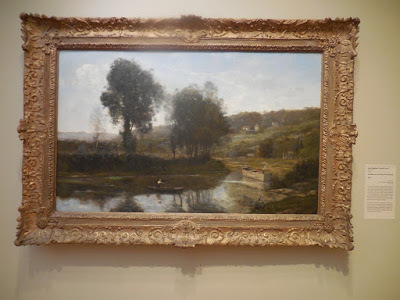 Jean-Baptiste-Camile Corot. The Bend in the Seine at Port Marly, 1872
Jean-Baptiste-Camile Corot. The Bend in the Seine at Port Marly, 1872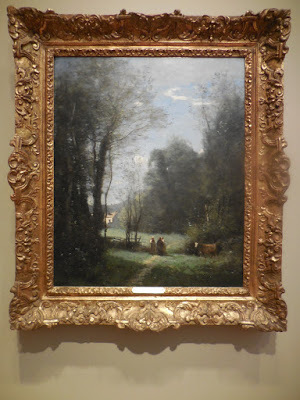 Jean-Baptiste-Camille Corot, The Maison Blanche of Sevres, 1872
Jean-Baptiste-Camille Corot, The Maison Blanche of Sevres, 1872The Cincinnati Art Museum was also showing a special exhibition of Raphael's Portrait of a Lady with a Unicorn. painted about 1505-06 from the Galleria Borghese in Rome. The image below is from Wikipedia Commons.
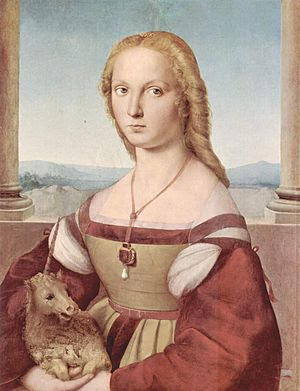
The exhibition is entitled "Sublime Beauty: Raphael’s Portrait of a Lady with a Unicorn" and will run until January 03, 2016. Here is the museum's description: "The Cincinnati Art Museum and the Fine Arts Museums of San Francisco in collaboration with the Foundation for Italian Art and Culture, presents Raphael’s Portrait of Lady with a Unicorn on loan from the Galleria Borghese in Rome. Painted about 1505, this mysterious blond and blue-eyed sitter epitomizes Raphael’s excellence in female portraiture during his Florentine period."
For more, click here.
And to conclude, later in the day, we drove through Chicago under the usual signs!
Road Construction Ahead. All lanes.

Published on November 16, 2015 00:30
November 13, 2015
THE DUKE OF WELLINGTON TOUR VISITS BASILDON PARK
THE DUKE OF WELLINGTON TOUR VISITS BASILDON PARKWe have written about Basildon here in the past. Click here to see our previous post.
Victoria here. This trip in September 2014, my second visit to Basildon, was indeed a delight. Not only was I with a wonderful group on the Duke of Wellington Tour; the National Trust now allows non-flash photographs and I went wild with snapping with both my camera and my phone.
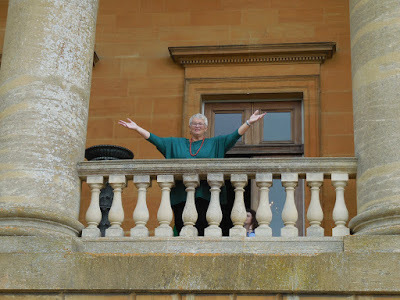 Susan dashed ahead to welcome us from the Piano Nobile Balcony
Susan dashed ahead to welcome us from the Piano Nobile Balcony
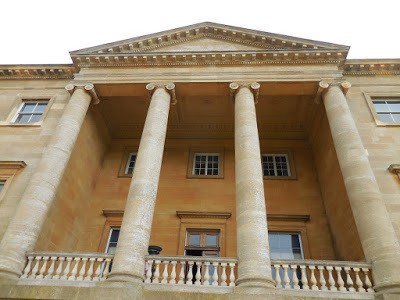 The East Front
The East Front
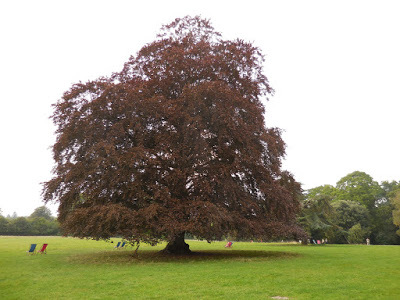 Copper Beech, I assume
Copper Beech, I assume
Basildon Park was built between 1776 and 1782 by Sir Francis Sykes, created a baronet in 1781. His roots were in Yorkshireand he chose architect John Carr of York (1723–1807) to build his house, a classical Palladian villa with a main block of rooms joined to pavilions on either side. The Sykes fortune was made during his service in India.Carr had previously worked with Robert Adam, and Adam's style clearly influenced the Palladian exterior as well as the decor of many rooms in the interior. The house as it stands today is the survivor of multiple owners, periods of abandonment, and occupation by soldiers and war prisoners in World Wars I and II. So it combines dazzling restorations of original features with comfortable furnishings and artwork from the 1950's when the house was acquired and restored by Lord and Lady Iliffe.
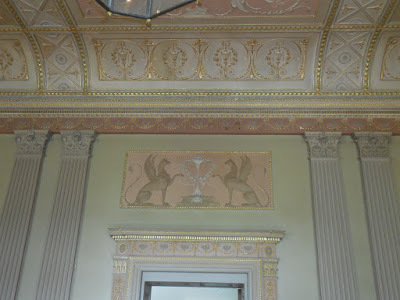 Etruscan panels in the Hall
Etruscan panels in the Hall
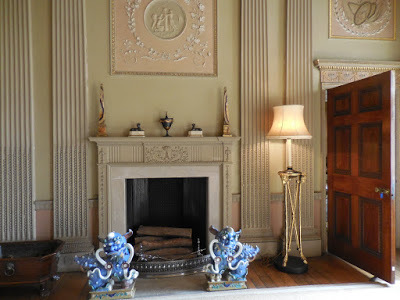
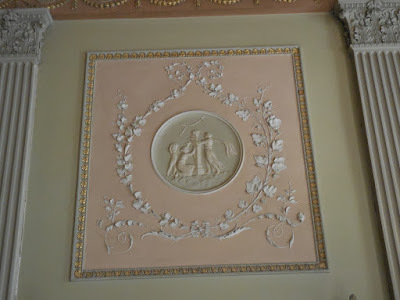 Above the fireplace
Above the fireplace
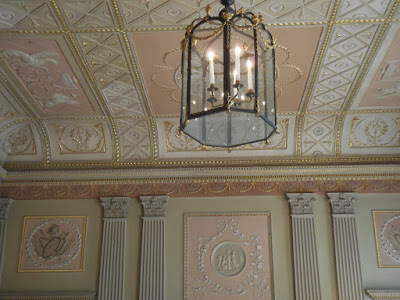 Ceiling
Ceiling
The library opens off the hall, magnificent yet cozy with its scarlet walls and huge book case. Who among us could resist sinking into the sofa with some selections from the shelves?
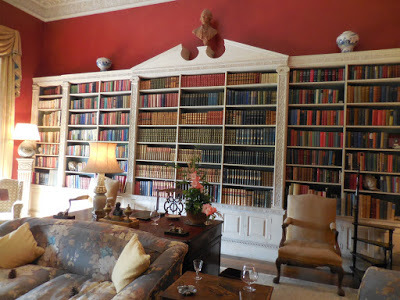
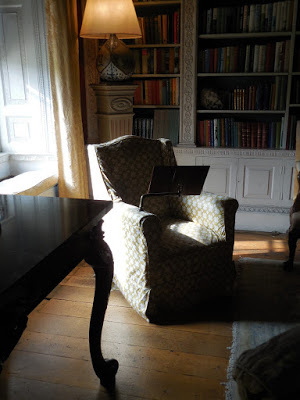 My corner?
My corner?
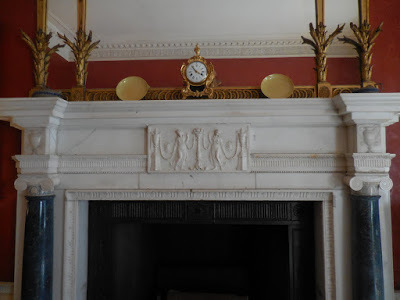
The chimneypiece and other architectural features came from Panton Hall in the 1950's to replace the originals which were lost in a fire in 1946. Panton Hall in Lincolnshire had been remodeled by Carr of York; it was demolished in 1964
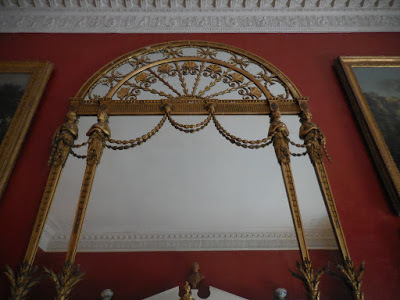 Library Mirror
Library Mirror
In the center of the house is the grand staircase, and Donna is shown admiring the piano and pianist who entertained us as we roamed the rooms.
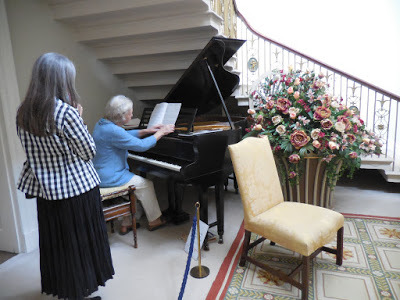
Marilyn and others admire the furnishings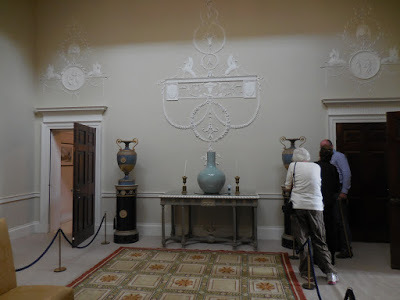
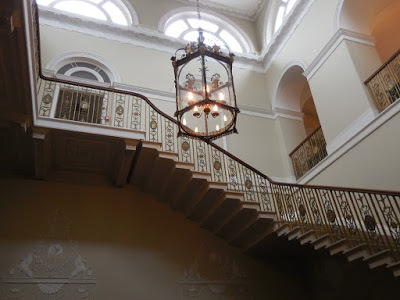
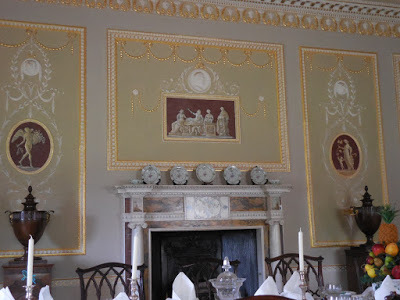 Dining Room
Dining Room
In the dining room, more influences of the Adam Brothers are found in the wall decoration.
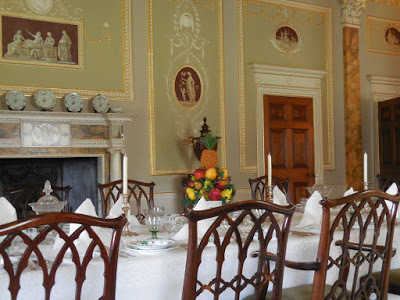
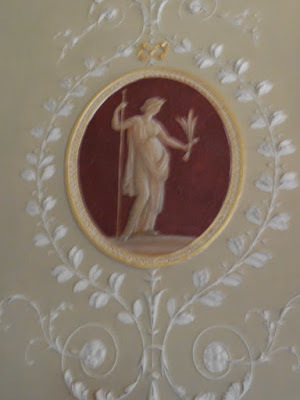
The ceiling lunettes and medallions show Roman scenes.
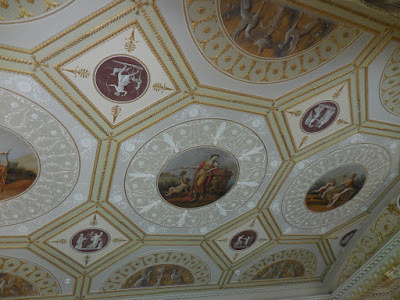
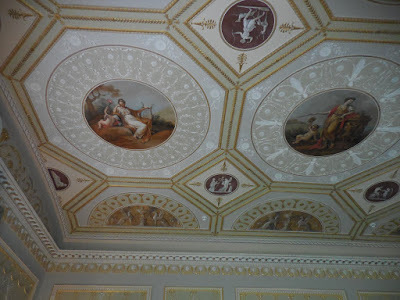
A screen of scagliola columns at one end of the dining room.
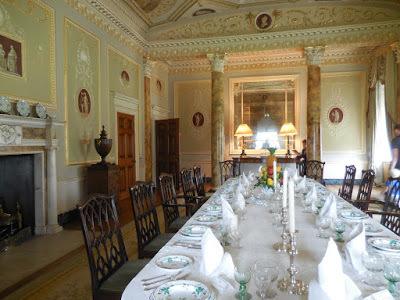
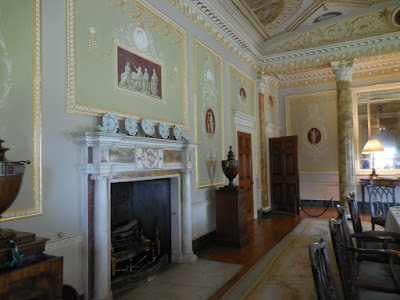
At the center back of the house is the Octagon Drawing Room. Venetian windows overlook the park and beyond to the Thames.
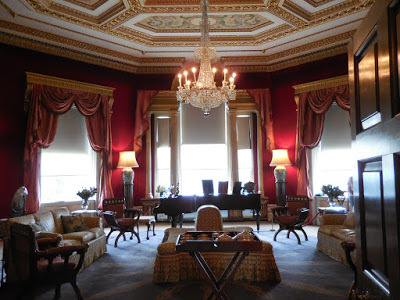
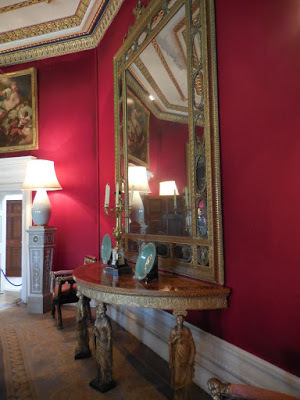 Pier Glass and table
Pier Glass and table
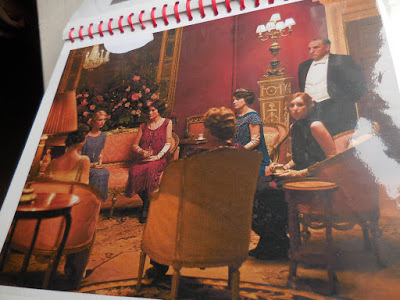 Display of shots from filming of Downton Abbey which used the Octagon Drawing Room to serve as the drawing room of the Grantham House, the family's London residence. The dining room was also used in DA for ballroom scenes.
Display of shots from filming of Downton Abbey which used the Octagon Drawing Room to serve as the drawing room of the Grantham House, the family's London residence. The dining room was also used in DA for ballroom scenes.
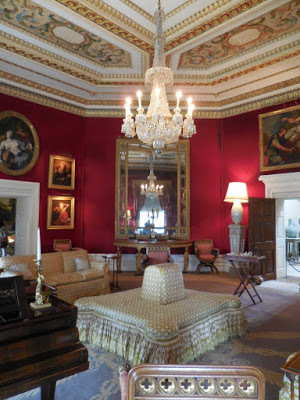 Perfect for the center, and quite clearly 20th century.
Perfect for the center, and quite clearly 20th century.
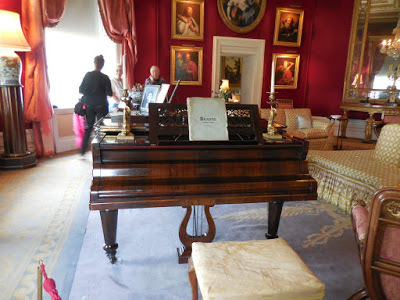 Kristine and Nancy have been peeking out the windows.
Kristine and Nancy have been peeking out the windows.
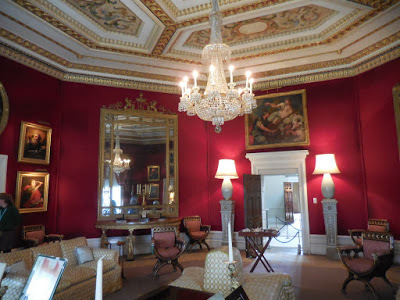
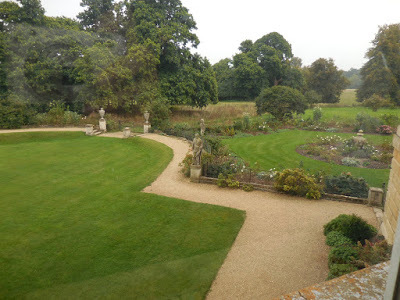 So I had to have a peek too!
So I had to have a peek too!
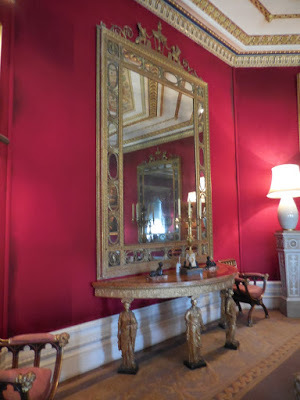 Pier glass and table
Pier glass and table
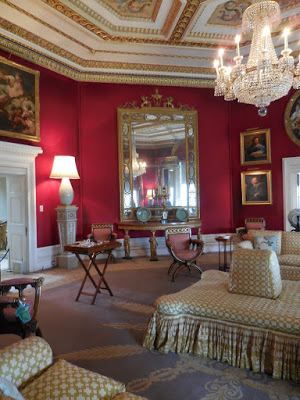
Adjacent to the Octagon Room is the Green Drawing Room, originally the breakfast room.
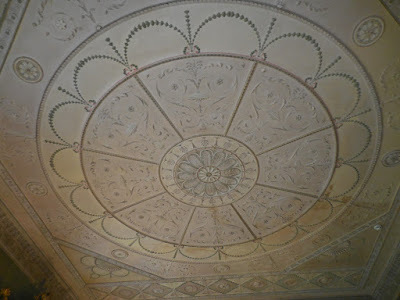 Ceiling medallion in the Green Drawing Room.
Ceiling medallion in the Green Drawing Room.
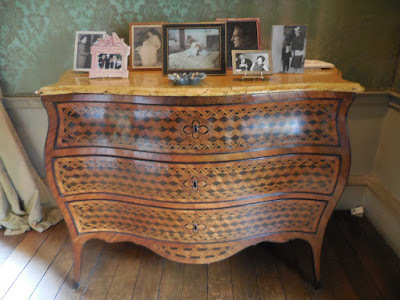 A serpentine marquetry commode with marble top shows photos from the Iliffe days.
A serpentine marquetry commode with marble top shows photos from the Iliffe days.
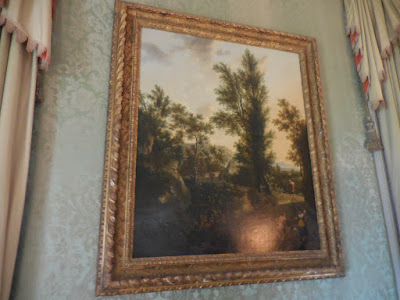 One of the collection of landscapes in the room
One of the collection of landscapes in the room
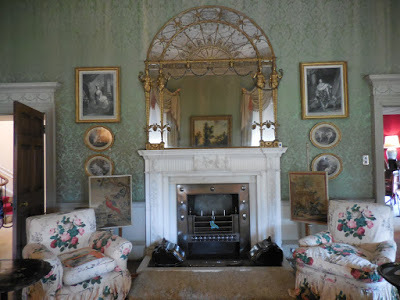 The chimneypiece is original to the house and may be the work of sculptor Richard Westmacott the elder
The chimneypiece is original to the house and may be the work of sculptor Richard Westmacott the elder
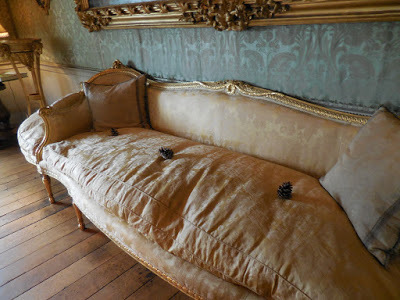 Dried thistles reminded us not to sit on the damask sofa
Dried thistles reminded us not to sit on the damask sofa
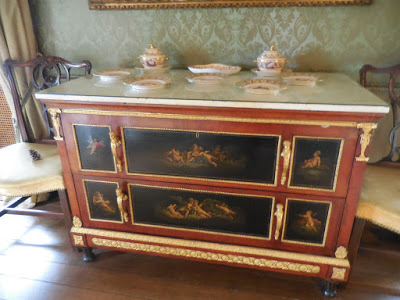 Cupids play on the panels of this commode
Cupids play on the panels of this commode
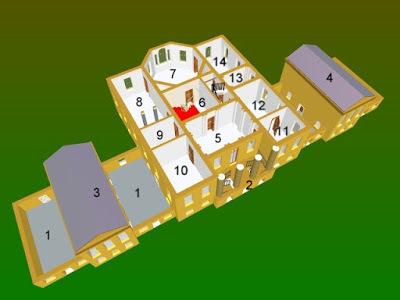 Diagram of the Piano Nobile (1st floor) from Wikipedia
Diagram of the Piano Nobile (1st floor) from Wikipedia
The first floor. 1: The four service courts; 2: Portico and West front; 3: North Pavilion; 4: South Pavilion; 5: Entrance Hall; 6: Staircase Hall; 7: Octagon Drawing Room; 8: Dining Room; 9: Study; 10: Library; 11: Sutherland Room (formerly lady Iliffe's sitting room); 12: Kitchen (since 1952); 13: larder (?); 14: Green Drawing Room (formerly Breakfast or Small Dining Room).
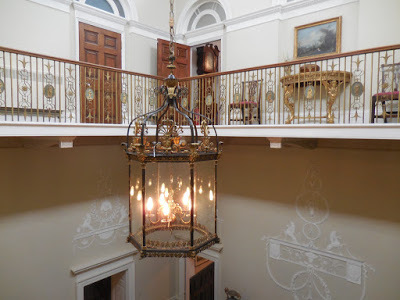 The balcony above the staircase
The balcony above the staircase
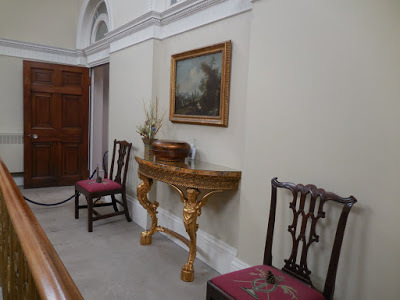
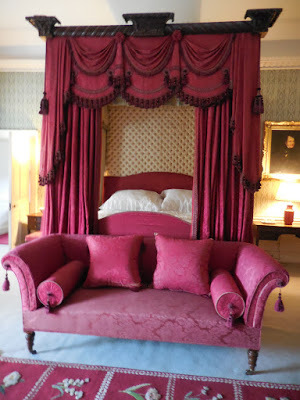 The Crimson Bedroom
The Crimson Bedroom
Lord and Lady Iliffe acquired this state bed form the sale at Ashburnham Place in 1953.
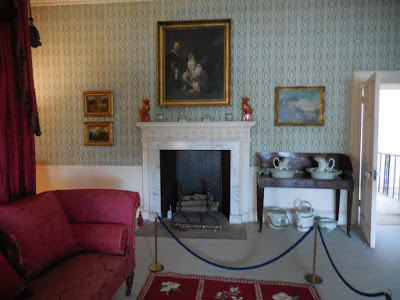 The Spode service on the washstand also comes from Ashburnham
The Spode service on the washstand also comes from Ashburnham
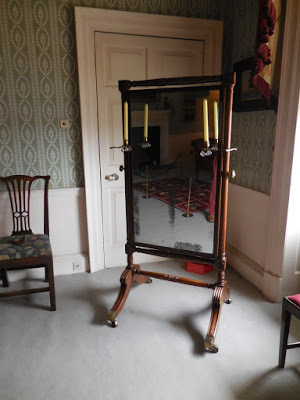 Mahogany Cheval Glass
Mahogany Cheval Glass
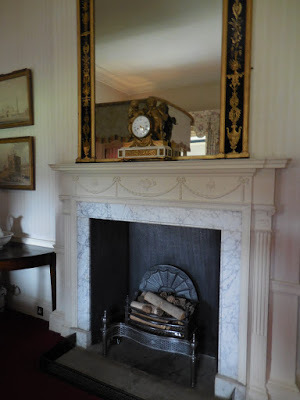
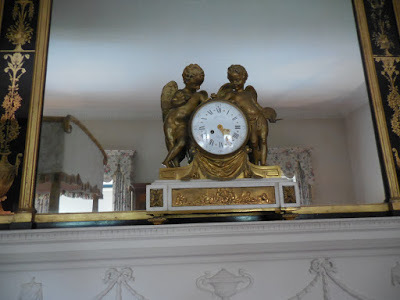
The Shell Room was probably an upstairs sitting room, now the home of a collection of shells collected by Lord Iliffe's mother.
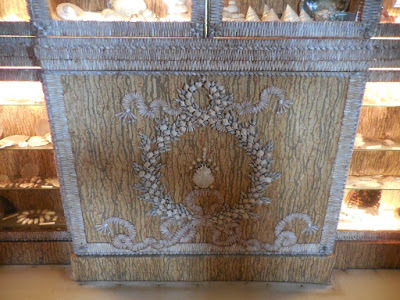
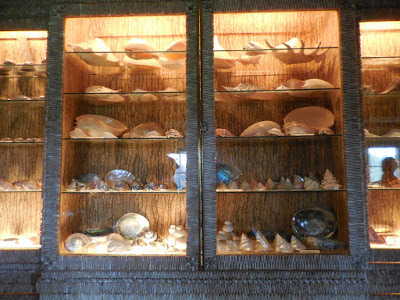
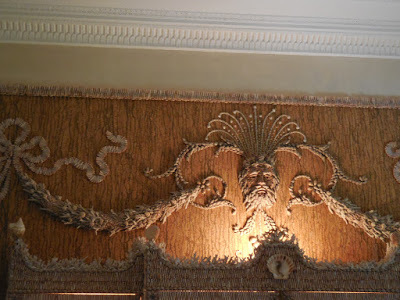
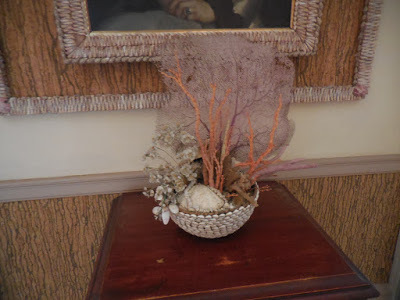
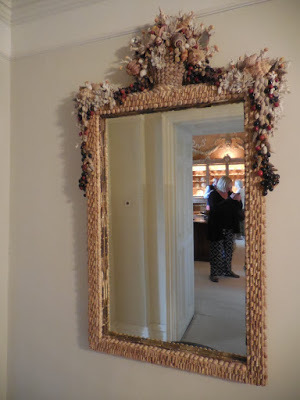
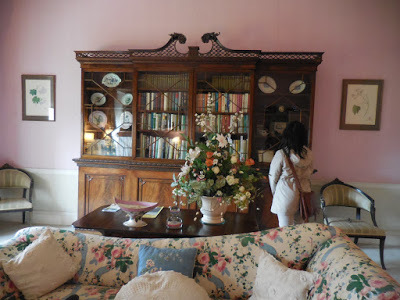 Ki admires another tempting bookcase
Ki admires another tempting bookcase
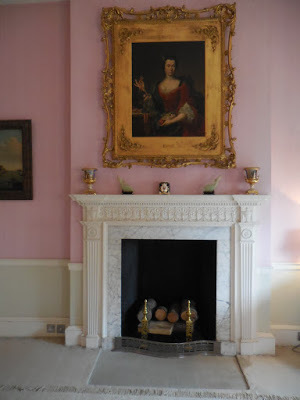
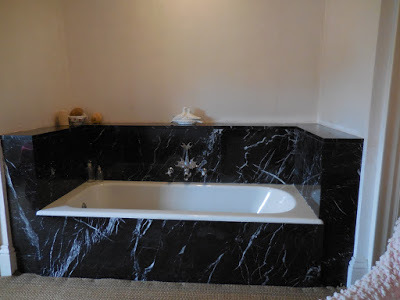 As befits a grand house of the 1950's Basildon was equipped with luxurious bathrooms, definitely not in the 18th century style.
As befits a grand house of the 1950's Basildon was equipped with luxurious bathrooms, definitely not in the 18th century style.
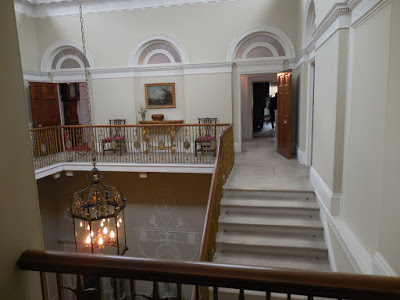
Wonderful 1950's kitchen...added by the Iliffes and bringing back childhood memories for many of us;
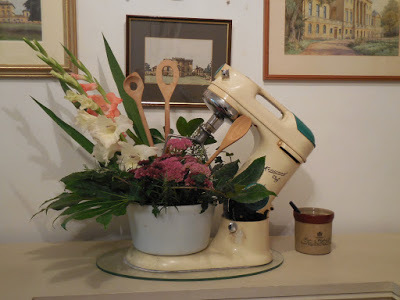
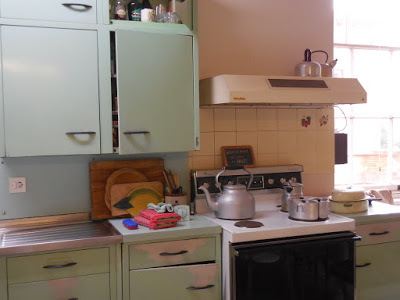
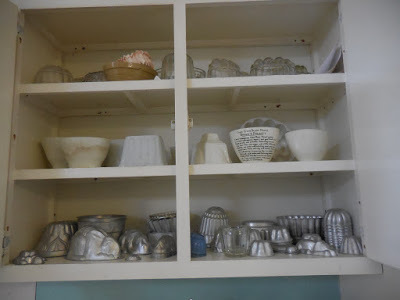
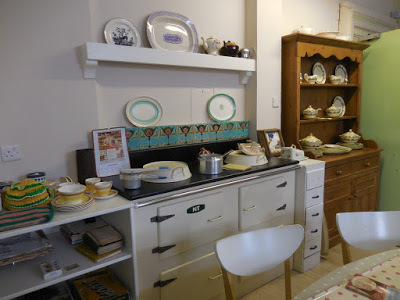
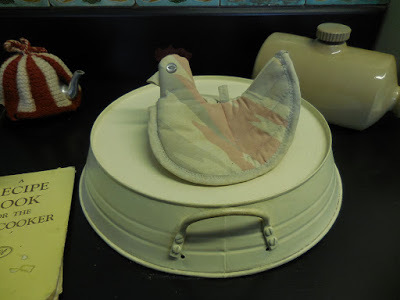
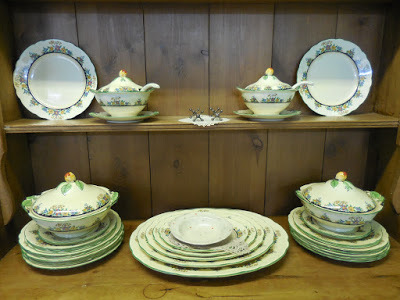
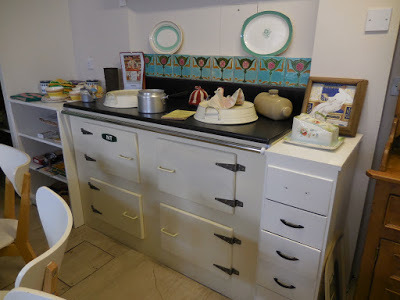
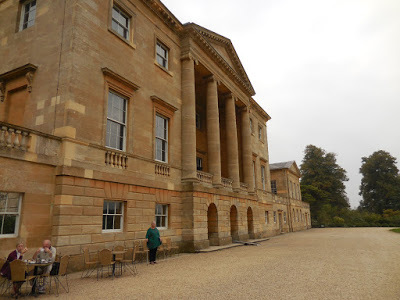 Susan lags behind as we say farewell to Basildon...but wait! There's more!
Susan lags behind as we say farewell to Basildon...but wait! There's more!
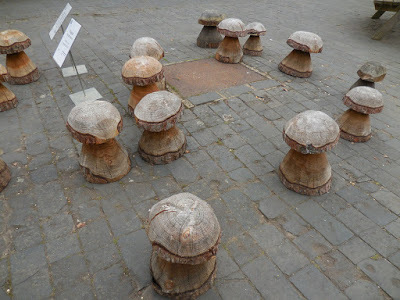
Outside the shop, we found this display of garden ornaments and we all wanted one! or two!
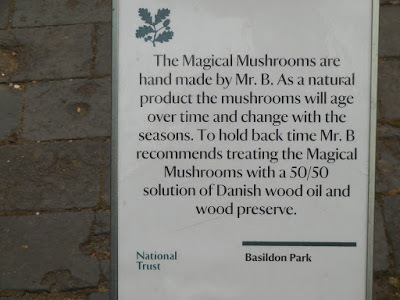
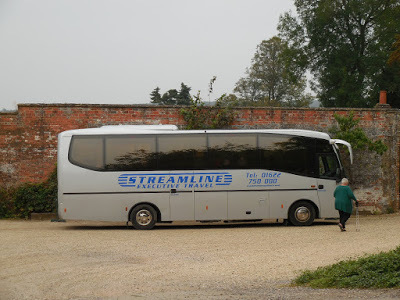 Not even Susan could figure out a way to get a magical mushroom home for her garden.This was our bus with out esteemed driver Graham.
Not even Susan could figure out a way to get a magical mushroom home for her garden.This was our bus with out esteemed driver Graham.
Though we were all tired, we had to agree that our day at two excellent houses -- Highclere Castle and Basildon -- had been worth every ounce of energy!
Onward to Windsor!
Victoria here. This trip in September 2014, my second visit to Basildon, was indeed a delight. Not only was I with a wonderful group on the Duke of Wellington Tour; the National Trust now allows non-flash photographs and I went wild with snapping with both my camera and my phone.
 Susan dashed ahead to welcome us from the Piano Nobile Balcony
Susan dashed ahead to welcome us from the Piano Nobile Balcony
 The East Front
The East Front Copper Beech, I assume
Copper Beech, I assumeBasildon Park was built between 1776 and 1782 by Sir Francis Sykes, created a baronet in 1781. His roots were in Yorkshireand he chose architect John Carr of York (1723–1807) to build his house, a classical Palladian villa with a main block of rooms joined to pavilions on either side. The Sykes fortune was made during his service in India.Carr had previously worked with Robert Adam, and Adam's style clearly influenced the Palladian exterior as well as the decor of many rooms in the interior. The house as it stands today is the survivor of multiple owners, periods of abandonment, and occupation by soldiers and war prisoners in World Wars I and II. So it combines dazzling restorations of original features with comfortable furnishings and artwork from the 1950's when the house was acquired and restored by Lord and Lady Iliffe.
 Etruscan panels in the Hall
Etruscan panels in the Hall
 Above the fireplace
Above the fireplace Ceiling
CeilingThe library opens off the hall, magnificent yet cozy with its scarlet walls and huge book case. Who among us could resist sinking into the sofa with some selections from the shelves?

 My corner?
My corner?
The chimneypiece and other architectural features came from Panton Hall in the 1950's to replace the originals which were lost in a fire in 1946. Panton Hall in Lincolnshire had been remodeled by Carr of York; it was demolished in 1964
 Library Mirror
Library MirrorIn the center of the house is the grand staircase, and Donna is shown admiring the piano and pianist who entertained us as we roamed the rooms.

Marilyn and others admire the furnishings


 Dining Room
Dining RoomIn the dining room, more influences of the Adam Brothers are found in the wall decoration.


The ceiling lunettes and medallions show Roman scenes.


A screen of scagliola columns at one end of the dining room.


At the center back of the house is the Octagon Drawing Room. Venetian windows overlook the park and beyond to the Thames.

 Pier Glass and table
Pier Glass and table Display of shots from filming of Downton Abbey which used the Octagon Drawing Room to serve as the drawing room of the Grantham House, the family's London residence. The dining room was also used in DA for ballroom scenes.
Display of shots from filming of Downton Abbey which used the Octagon Drawing Room to serve as the drawing room of the Grantham House, the family's London residence. The dining room was also used in DA for ballroom scenes. Perfect for the center, and quite clearly 20th century.
Perfect for the center, and quite clearly 20th century. Kristine and Nancy have been peeking out the windows.
Kristine and Nancy have been peeking out the windows.
 So I had to have a peek too!
So I had to have a peek too! Pier glass and table
Pier glass and table
Adjacent to the Octagon Room is the Green Drawing Room, originally the breakfast room.
 Ceiling medallion in the Green Drawing Room.
Ceiling medallion in the Green Drawing Room. A serpentine marquetry commode with marble top shows photos from the Iliffe days.
A serpentine marquetry commode with marble top shows photos from the Iliffe days. One of the collection of landscapes in the room
One of the collection of landscapes in the room The chimneypiece is original to the house and may be the work of sculptor Richard Westmacott the elder
The chimneypiece is original to the house and may be the work of sculptor Richard Westmacott the elder Dried thistles reminded us not to sit on the damask sofa
Dried thistles reminded us not to sit on the damask sofa Cupids play on the panels of this commode
Cupids play on the panels of this commode Diagram of the Piano Nobile (1st floor) from Wikipedia
Diagram of the Piano Nobile (1st floor) from WikipediaThe first floor. 1: The four service courts; 2: Portico and West front; 3: North Pavilion; 4: South Pavilion; 5: Entrance Hall; 6: Staircase Hall; 7: Octagon Drawing Room; 8: Dining Room; 9: Study; 10: Library; 11: Sutherland Room (formerly lady Iliffe's sitting room); 12: Kitchen (since 1952); 13: larder (?); 14: Green Drawing Room (formerly Breakfast or Small Dining Room).
 The balcony above the staircase
The balcony above the staircase
 The Crimson Bedroom
The Crimson BedroomLord and Lady Iliffe acquired this state bed form the sale at Ashburnham Place in 1953.
 The Spode service on the washstand also comes from Ashburnham
The Spode service on the washstand also comes from Ashburnham Mahogany Cheval Glass
Mahogany Cheval Glass

The Shell Room was probably an upstairs sitting room, now the home of a collection of shells collected by Lord Iliffe's mother.





 Ki admires another tempting bookcase
Ki admires another tempting bookcase
 As befits a grand house of the 1950's Basildon was equipped with luxurious bathrooms, definitely not in the 18th century style.
As befits a grand house of the 1950's Basildon was equipped with luxurious bathrooms, definitely not in the 18th century style.
Wonderful 1950's kitchen...added by the Iliffes and bringing back childhood memories for many of us;







 Susan lags behind as we say farewell to Basildon...but wait! There's more!
Susan lags behind as we say farewell to Basildon...but wait! There's more!
Outside the shop, we found this display of garden ornaments and we all wanted one! or two!

 Not even Susan could figure out a way to get a magical mushroom home for her garden.This was our bus with out esteemed driver Graham.
Not even Susan could figure out a way to get a magical mushroom home for her garden.This was our bus with out esteemed driver Graham.Though we were all tired, we had to agree that our day at two excellent houses -- Highclere Castle and Basildon -- had been worth every ounce of energy!
Onward to Windsor!
Published on November 13, 2015 04:33
Kristine Hughes's Blog
- Kristine Hughes's profile
- 6 followers
Kristine Hughes isn't a Goodreads Author
(yet),
but they
do have a blog,
so here are some recent posts imported from
their feed.














